In the Argentinian part of Patagonia we lived the geographer’s dream among glaciers and spectacular mountains.
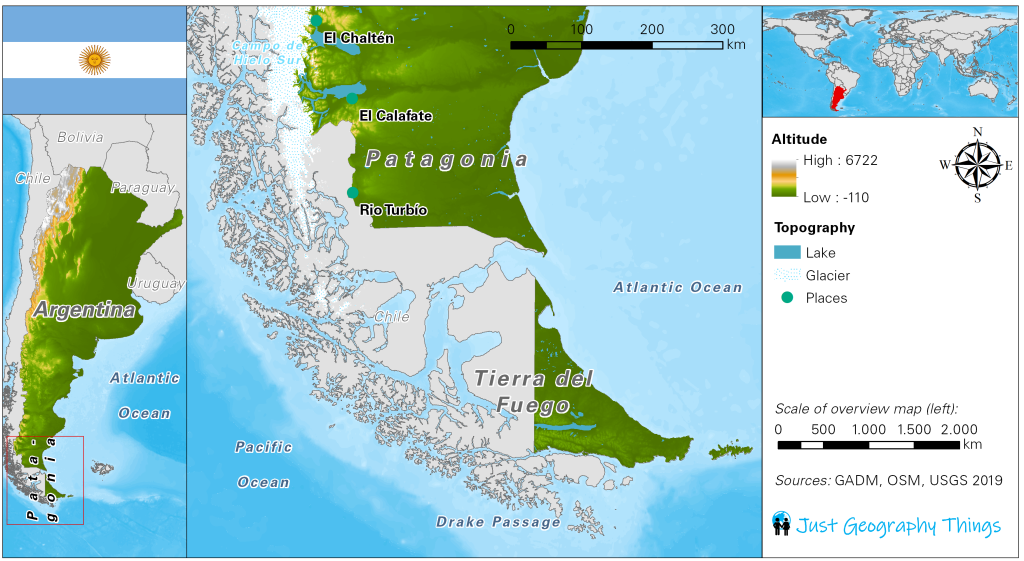
El Calafate (12.12. -16.12.19)
The alarm clock rings early again. After we had a nice break at the Camping Güino in Puerto Natales, today we had a novelty – hitchhiking with border crossing! Therefore, the tactic was to stand at the exit road at an early hour and to hold our lovingly painted sign with El Calafate in the air.
Since the exit road is unfortunately directly on the water, this was a rather windy affair. Already after four hours we were rewarded! An Argentinean took us over the nearby border crossing to Río Turbio. Afterwards everything went much faster: from Río Turbio we waited 10 minutes for a ride to Ruta 40 and then also 10 minutes for the remaining three hours of the ride. The nice Argentinean-Colombian couple with a practical Travel-Mate mug even drove una to a campground near the center of El Calafate.
The main reason for our visit to El Calafate was the proximity to the probably most famous glacier of Argentina – the Perito Moreno Glacier. When we got up early the next day again to hitchhike to the glacier, admittedly, however, still were quite wheeled from the day before, we decided after three hours of unsuccessful waiting to start the way back to the tent and to sleep properly.
Nevertheless, the day should still end conciliatory. At the campground we met an older couple from New Zealand again, which we had already met in Puerto Natales and were immediately asked to participate in the barbecue evening. So we found ourselves with our army cutlery and plastic bowls in the middle of a group of four Overlander couples or families – as the only backpackers without a car. The meat was already worried and was – as it should be for Argentine meat – great! And it was plentiful, so that there was another asado the following evening.


At the campground there was a lot of coming and going and so we got to know a Dutch couple who fortunately took us to the glacier the next morning in their rental car – so we were spared another hitchhiking attempt.
The about 1.5 hour drive led us past the huge Lago Argentino, rock walls and a dead armadillo before we arrived at the glacier. Before we could enjoy the view from the nearby balconies, we could already hear the cracking sounds of the falling ice blocks. We hurried a little bit more each time to catch a glimpse of the crashing boulders as well.

The Perito Moreno Glacier, named after a Spanish explorer, is a real speciality. The glaciers in Patagonia are shrinking, much slower than in the Alps, but the Perito Moreno Glacier has been stable since 1907. It is close to the opposite moraine and builds up an ice blockage over the years, which is then washed away by the water of the two lakes and glacier water – then the resulting arch collapses and the slow spectacle starts all over again.
Because of the moraine, you can get very close to the glacier – as the crow flies, it is only about 200 metres. Then the impressive up to 70 meter high ice wall builds up in front of the observers and inspires amazement. Then everybody is waiting for a piece of ice to fall. We too happened to be standing at the balcony at the right time.

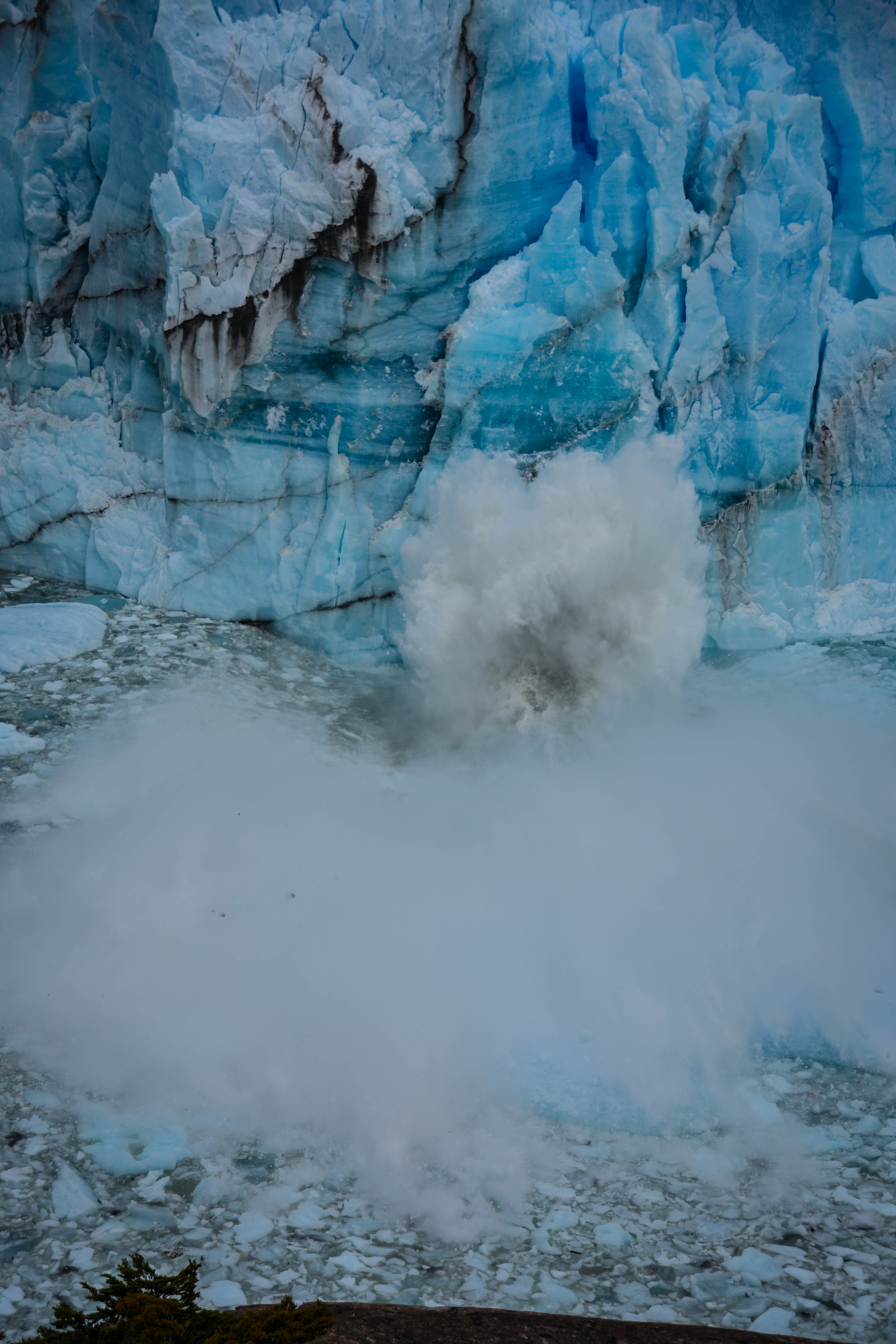
It’s the third biggest glacier of Argentina and streches as far as the eye can see
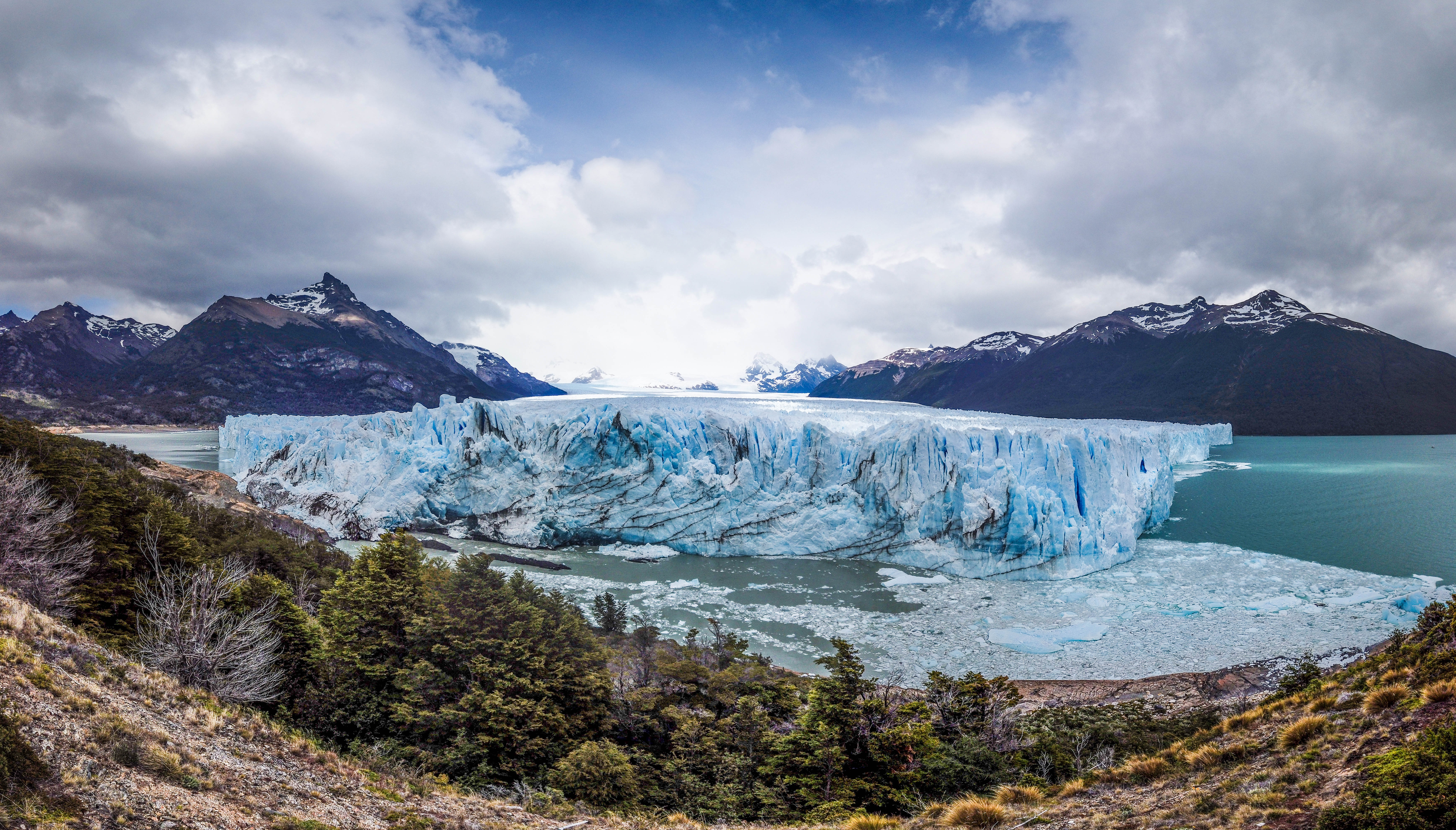
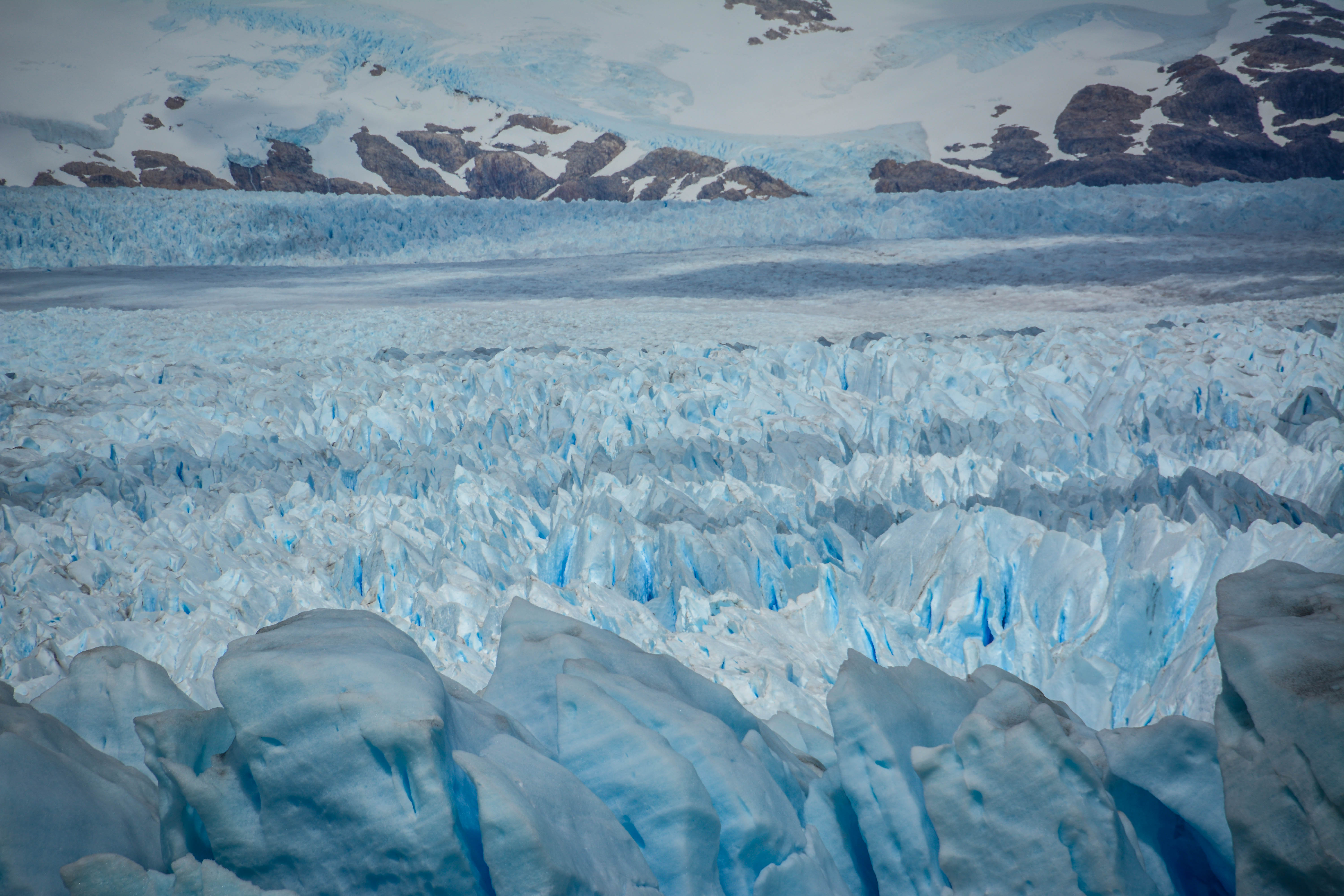

Of course the Karakara, which we had already seen a few times in Patagonia, was not to be missed:
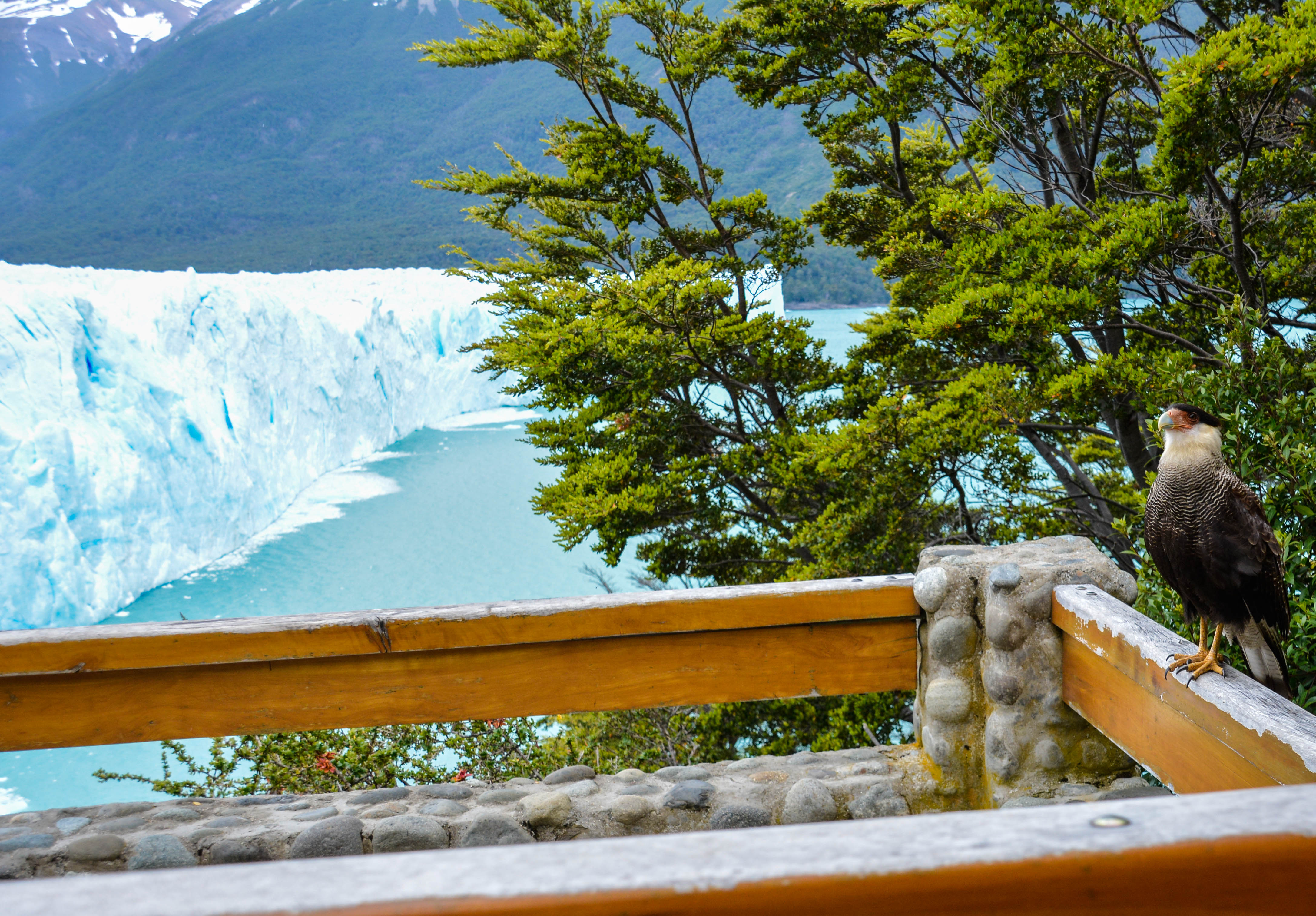
The most common explanation for the stability of the glacier, despite the general climate change, is that although less snow falls, more humid air is brought over the oceans to Patagonia and therefore it rains more. The glacier is therefore in a favourable position and feeds mainly on rainwater that freezes due to the low temperatures (maximum 12 degrees in summer).
After saying goodbye to the glacier with a heavy heart when the rain slowly started to fall, we were able to take the picturesque road back to El Calafate. This time we made a small stop at Lago Argentino:
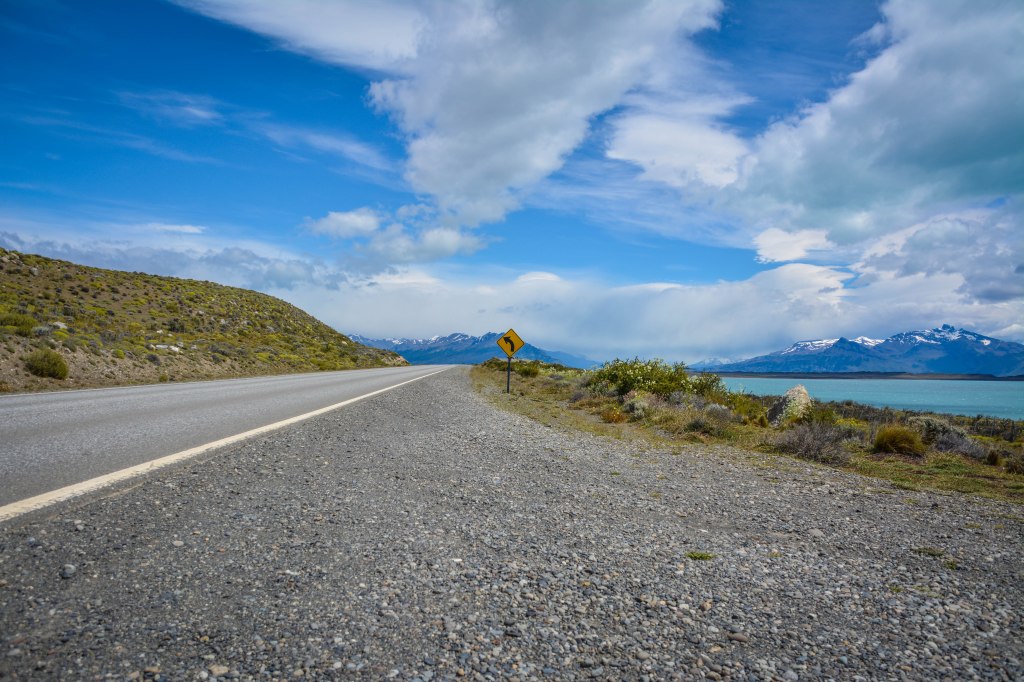
Back at the campground we met another bird that reminded us a bit of a kiwi, but where evolution had not gone wrong.
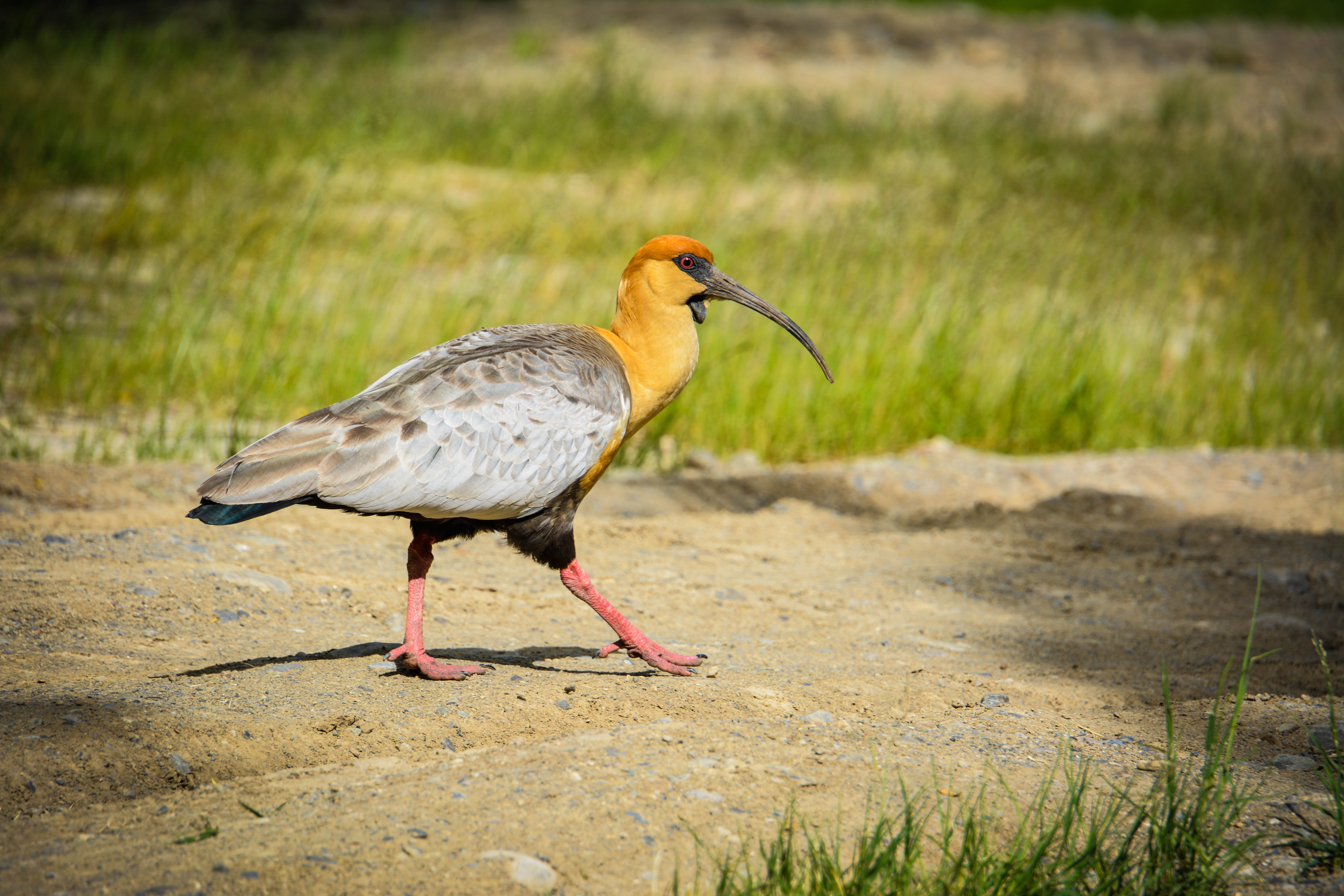
Then it was hitchhiking again. Our destination this time was the small hiking place El Chaltén. But after 1.5 hours we had already found an Argentinean couple who kindly took us to El Chaltén.
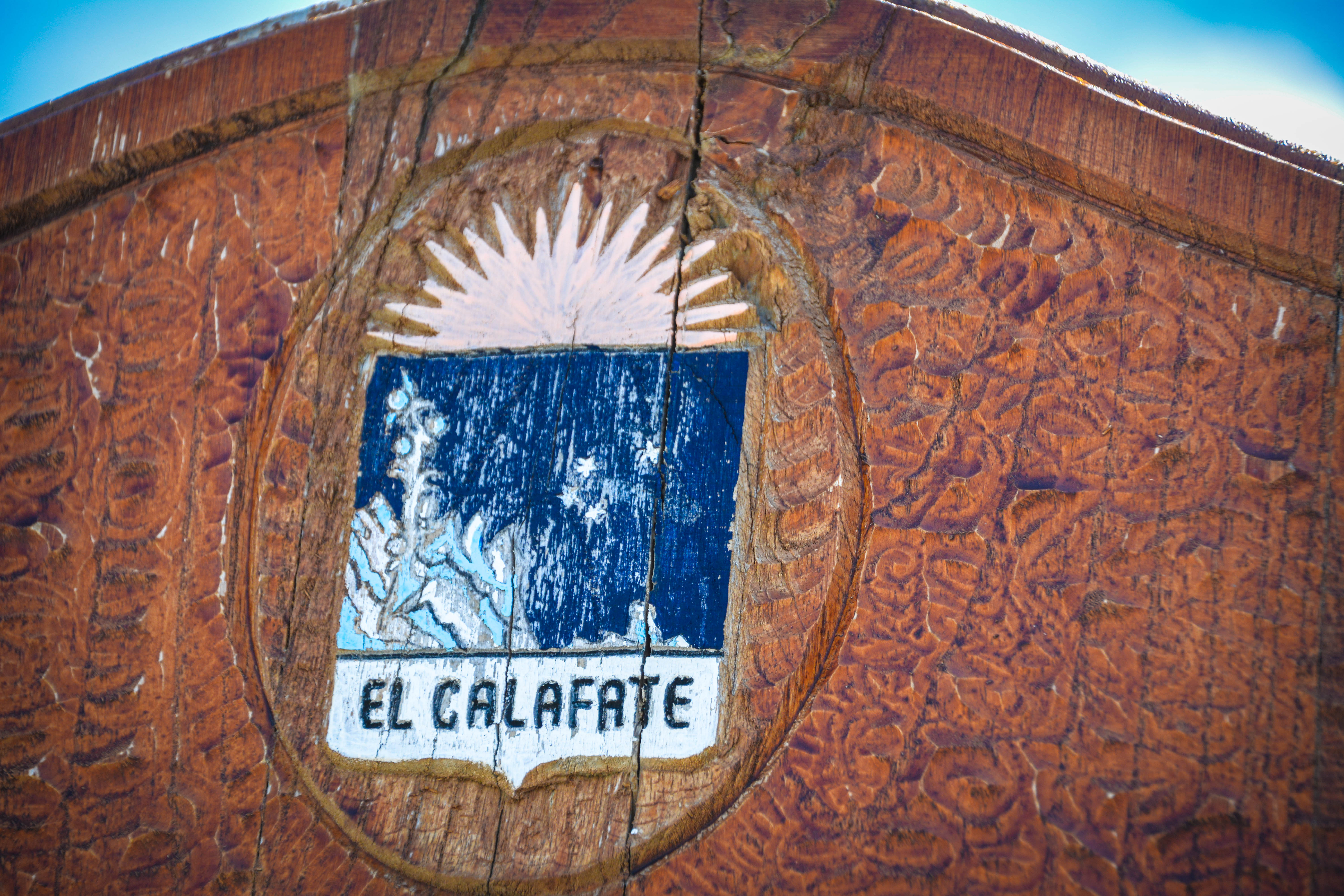

El Chaltén (16.12. – 28.12.19)
The approach to El Chaltén is spectacular. It passes first Lago Argentino and later Lago Viedma, both of which lie like turquoise blue pearls in the otherwise grey-brown landscape with white spots.

On the last kilometres before our destination we can already begin to understand the reason for our visit to the area. Behind a few clouds the Fitz-Roy-Passage is hidden, which we could already see on our flight from Santiago de Chile to Punta Arenas.

The couple that took us from El Calafate offered us to make another little tour through the village of El Chaltén to show us everything. „Si tienen el tiempo“ The answer was, „Si, si son solo 10 minutos!“
Although El Chaltén is the hiking capital of Argentina, it is very small. Just 2,000 people live here – that’s a maximum of 8,000 (day) tourists per day. The numbers have risen sharply in recent years and the town is therefore catching up rapidly – the Internet has been around for 6 years. However, the capacities have been designed so low that the network is now regularly overloaded to such an extent that a connection to the outside world is rarely possible. This wouldn’t be a problem either, if the weather wasn’t so changeable and one was dependent on the predictions of wind guru and consorts.
Not far from the village there is a huge network of hiking trails. The entrance to the national park is free of charge and we didn’t have to pay for the campsites in the park either – a welcome change after the organizational effort in Torres del Paine in Chile. After we had chosen a suitable day, we packed our stuff at noon and set off. The hike was short, but extremely windy. Our destination for the day was the wooded campground Poinchenot, which is located at the foot of the ascent to the Lago de los Tres, which in turn is located at the foot of the Fitz Roy. When we started walking it was raining and it was very windy, but as usual the weather was changing constantly anyway. Hordes of day tourists come towards us, who stare at our big backpacks a little incredulously and unfortunately do not know the basic rules of hiking.
But when we arrive at the campground we have left these hikers behind us and pitch our tent in the wind. Fortunately, however, meanwhile we are very experienced and routinely what concerns this. Afterwards we collected wood to protect our tent a little bit more from the strong wind. But the wind is omnipresent and the trees and branches above us bend loudly in the wind.
The next morning the alarm clock rings very early again. Or rather in the night. It’s still pitch-black as the lovely melody wakes us up at 3.45 am. We leave our tent and set off for Lago de Los Tres. There are a few clouds in the sky and during the icy ascent the sun slowly rises.

But the more impressive light show takes place on the other side.



A short time later the sun was covered by a big cloud and the whole scenery lost its colour at once and looked black and white.
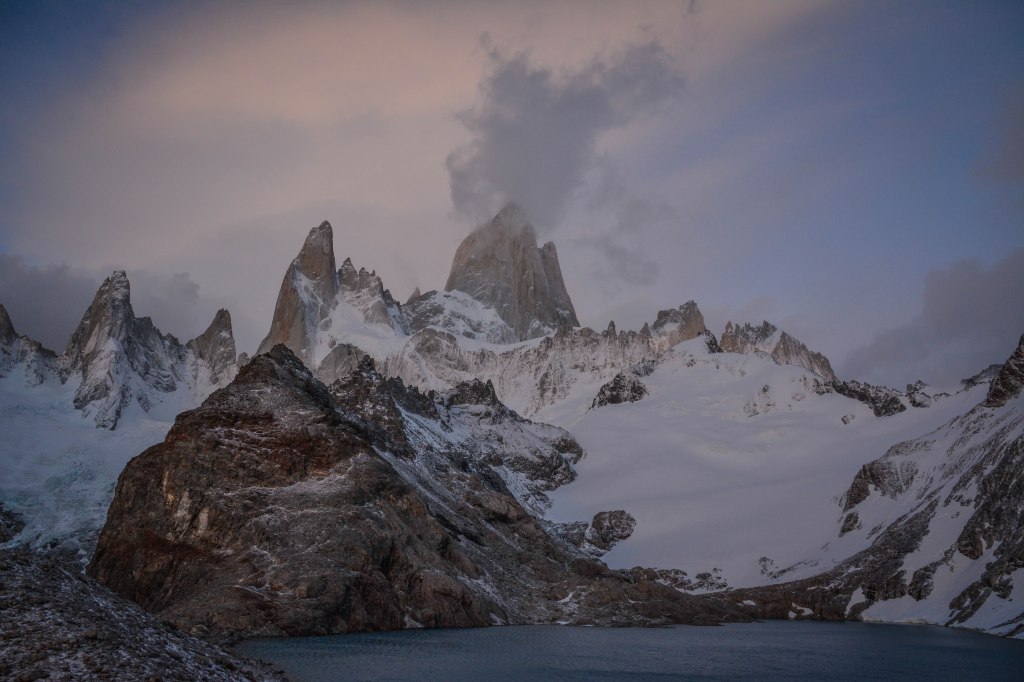
After we had enjoyed the view in detail, wind and icy temperatures forced us to return to the tent. But before we could see the sun a little bit.
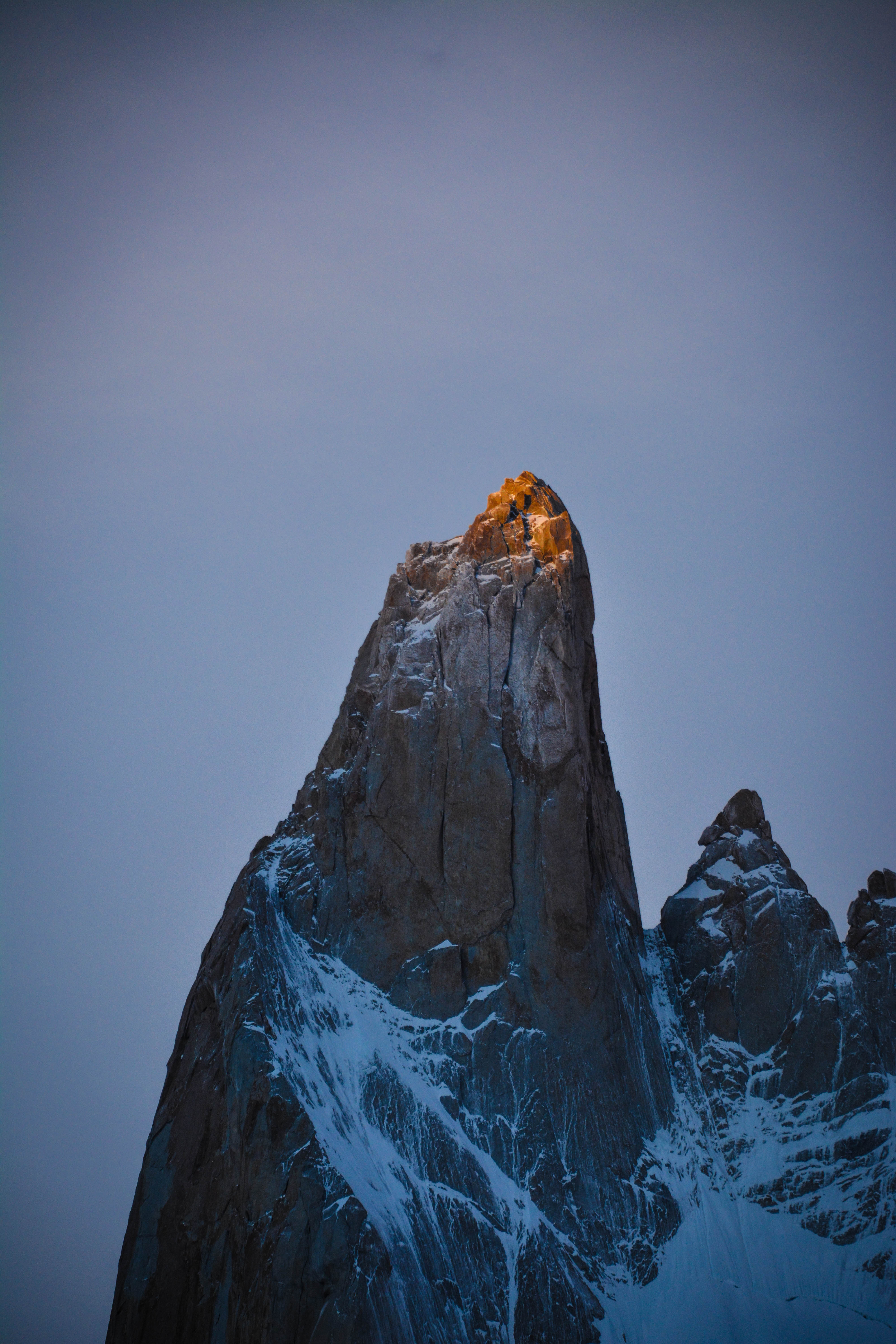
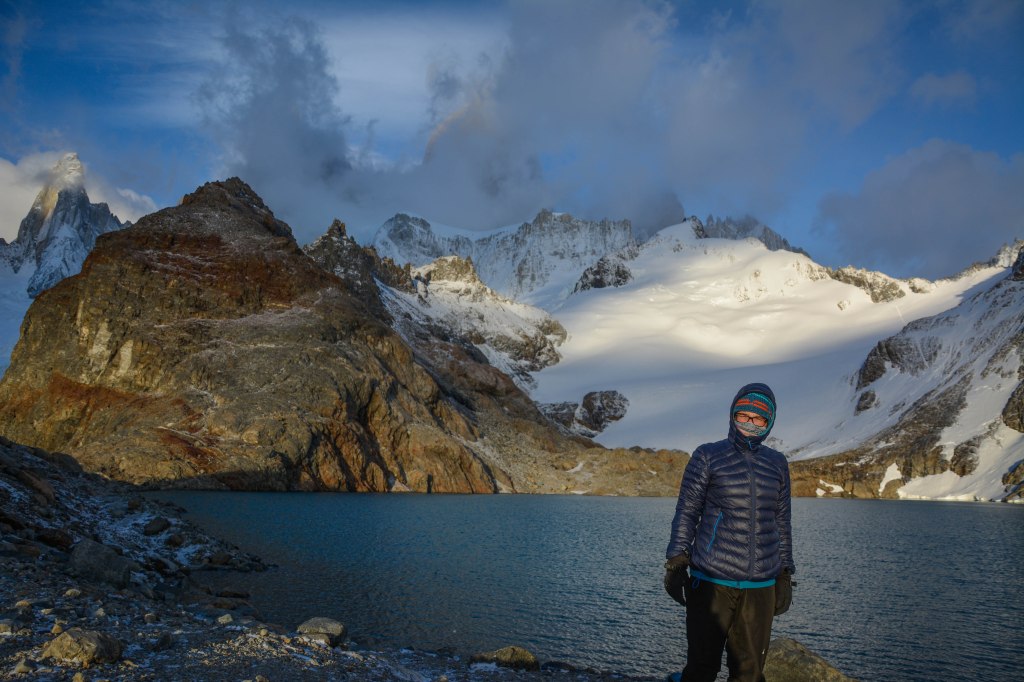
At the campground we first had a typical hiking breakfast – porridge with apples. After that, we continued our hiking tour in direction to Lago Torre, but we had to repeatedely make some breaks in order to enjoy the great view and the deserted intermediate stretch of the hiking tour.
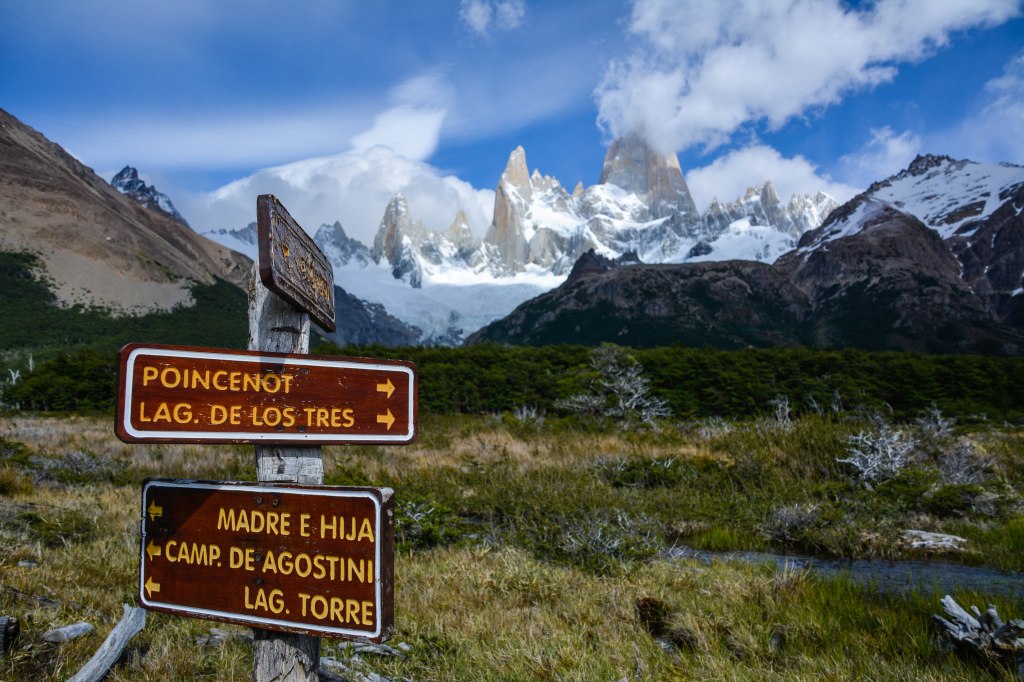

Arriving at Lago Torre, we were not completely on the sunny side anymore. The Cerro Torre that should rise 3.000m behind the lake had its top wrapped in a cloud dress. Thus, we could only put up our tent and watch the beginnings of the needle-like mountain.
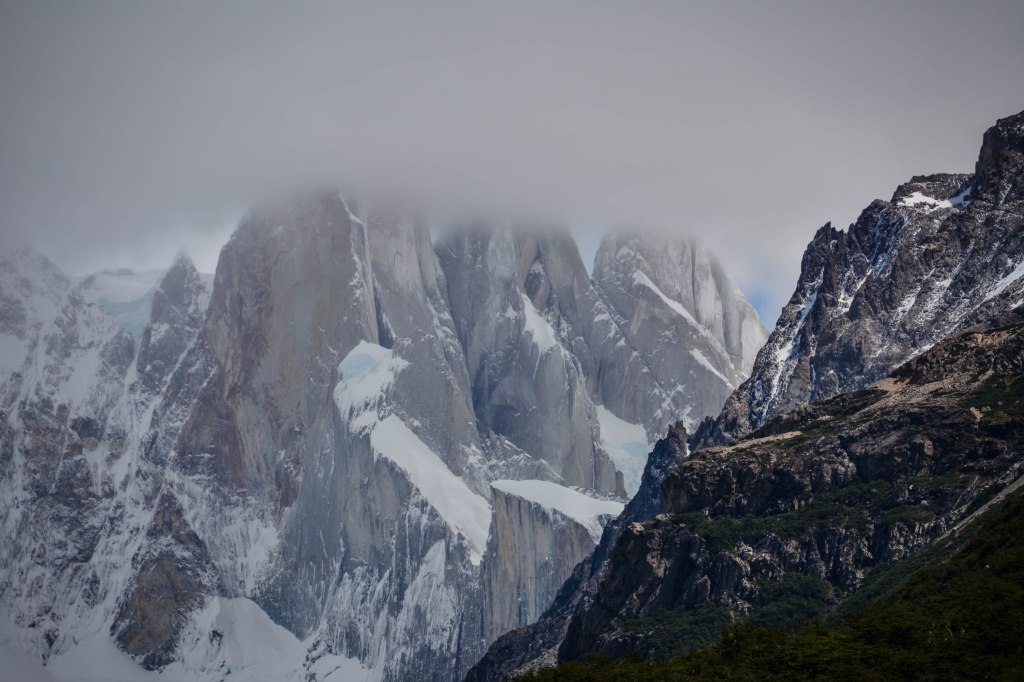

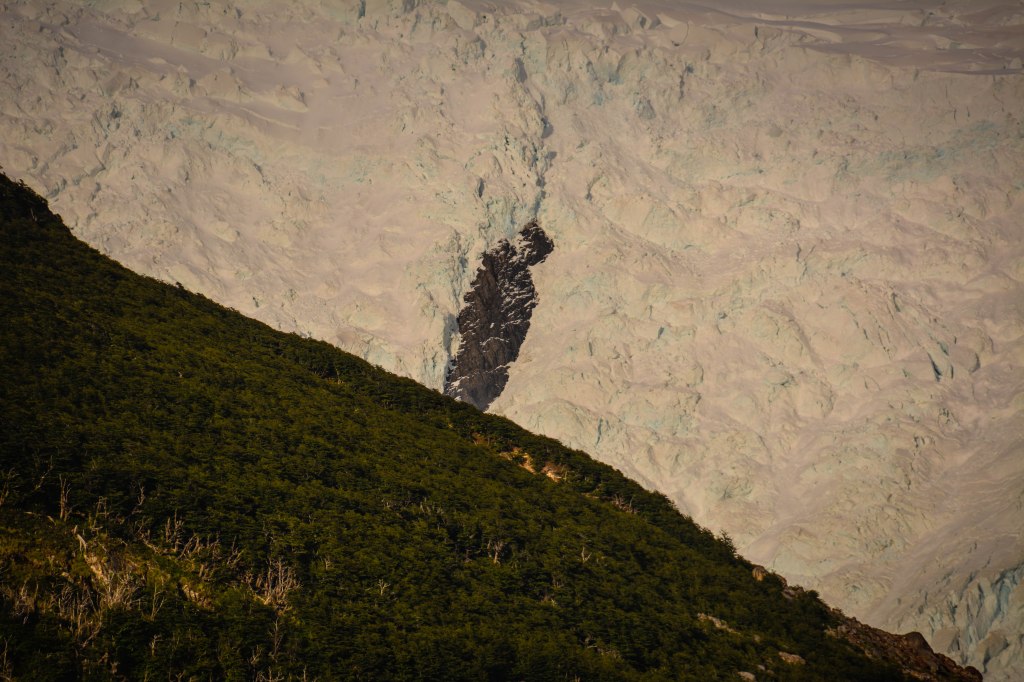


On the way back we used every viewpoint to try again to see the Cerro Torre – unfortunately without success.

Hooked by the beautiful view, after a few bad weather days we went to a lookout point near the village.

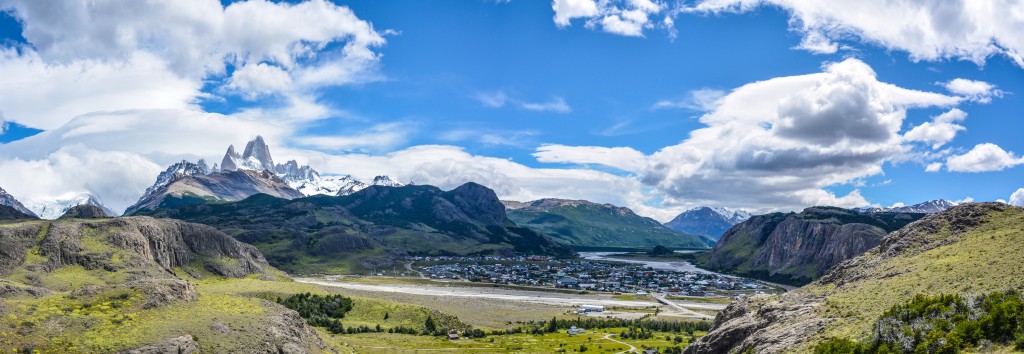
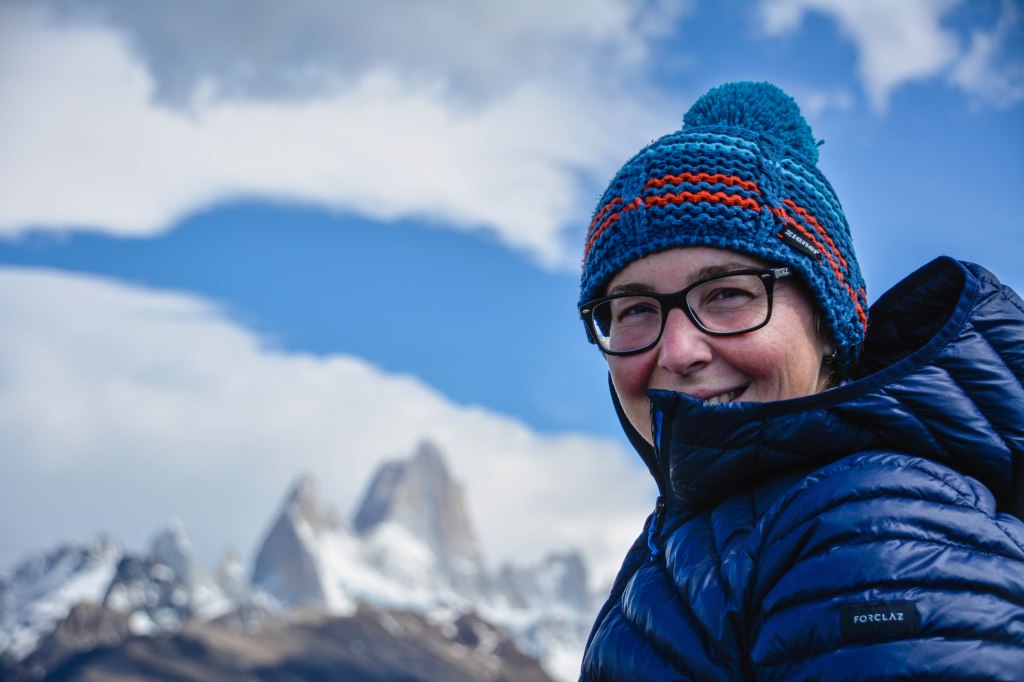

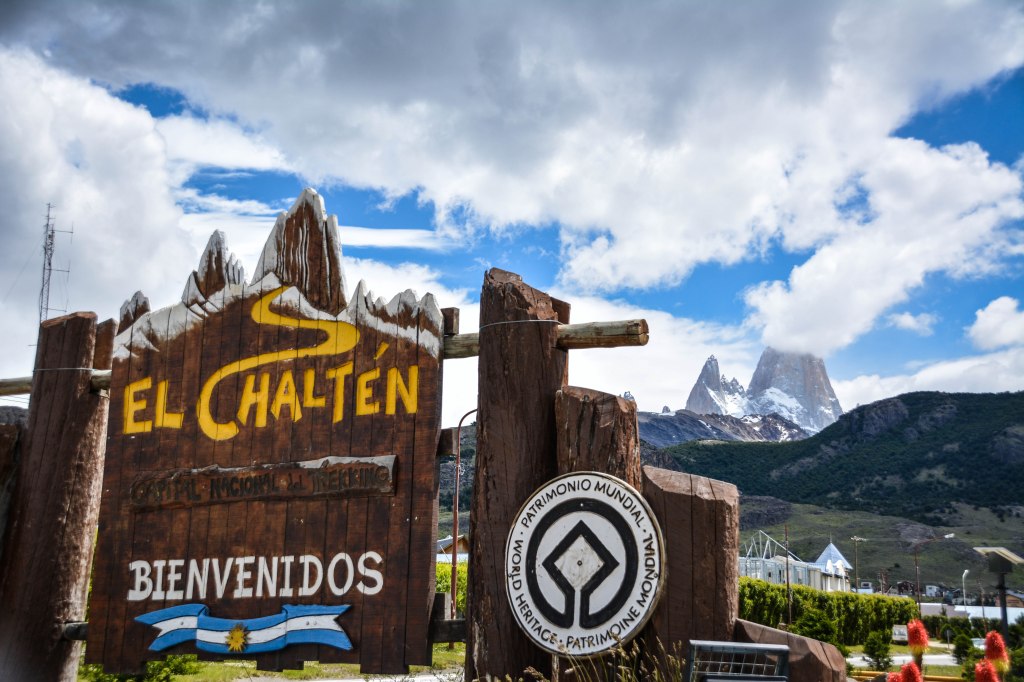

Because of the weather we still spend most of the time waiting. Nevertheless a highlight is rolling towards us: Christmas. At the campground of our trust a group has therefore gathered together to prepare an Argentinean lamb, a cordillero, in the right way: in one piece and over the fire.
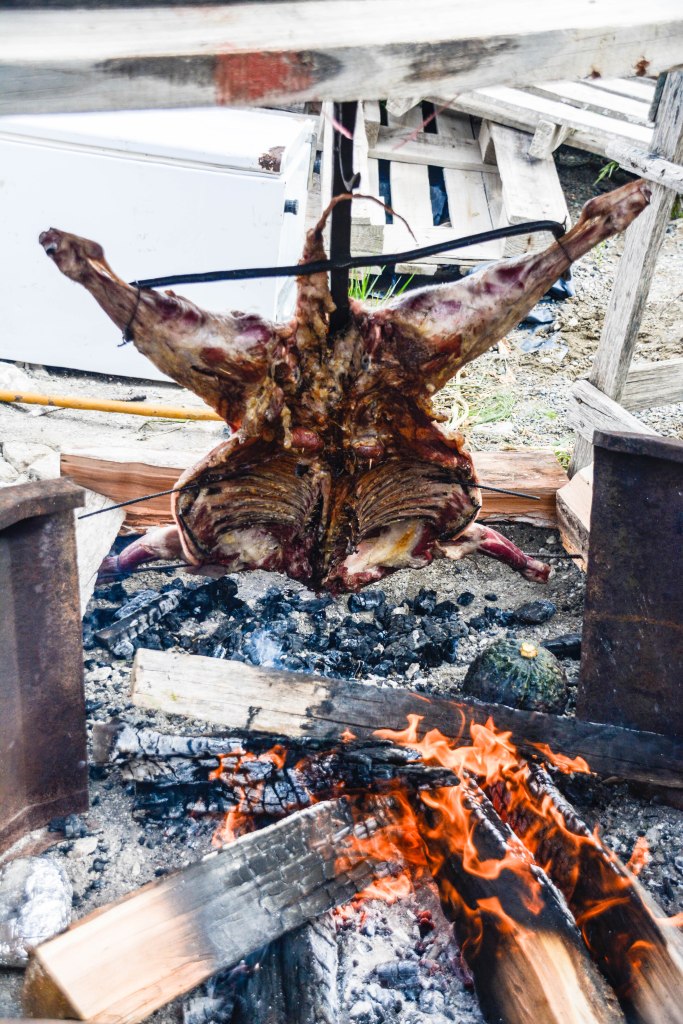

The evening was great and a real feast! Everyone in the group had contributed a typical Christmas meal from their home country. We had therefore contributed potato salad. So with lots of beer and a full stomach we celebrated Diana’s first and Lucas‘ second Christmas outside of Germany.
Vuelta al Huemul (27.12. – 30.12.19)
In our accommodation there was only one topic over the Christmas holidays: the Huemul Trek. Who is walking it and when? When is the weather good? Do you run another trek before? What about the wind? And the rain? During the Christmas holidays it rained and snowed a lot in and around El Chaltén (in the higher altitudes). And then there is still the passage that has to be crossed with a climbing harness on a zipline – in 15 meters height! But some people have told us that you can avoid this passage by crossing a river. But how high is the water level after it has rained so much?
But on 27.12. it is time and we decide to answer these questions for ourselves within the next 4 days. We got together in a group of five, Finn and Jirka from the campground and Leandro, a Brazilian we got to know through couchsurfing, join us. On the way to the office of the national park administration, which also marks the starting point of the hike, we borrow a climbing harness to cross the mentioned spot. As we start walking it is raining cats and dogs.
This was however included in the calculation. The trek takes 4 days and that the weather is perfect for 4 days is extremely rare. Only for the second day there should be no wind – a condition we have not really experienced in Patagonia so far. Our trusted weather service (Windguru.cz) has given us a promising forecast for our targeted time window – except for the first day.
Day 1
Administración de Parque Nacional to Campamento Lago Toro – 16,9 km
Before we finally get started, we have to register with the APN. As the hike is classified as difficult and difficult to access, every hiker has to do this. In addition, we have to watch a ten-minute PowerPoint video that suggests that we will surely die during the hike. An exaggerated warning as we think, but we have to go through it. Afterwards we fill out the form for international health insurance, emergency contact person and potential helicopter return transport and much later than planned we finally start the hike. The first hundred meters we share with tourists who only walk to the nearby view points from which one can normally see the Fitz Roy and/or the Cerro Torre – today, however, it is enough for a solid wall of fog and rain.
So we go on our way in the rain, but Patagonia would not be Patagonia if the weather would not change constantly. At the first point with a wide view we arrive in sunshine:

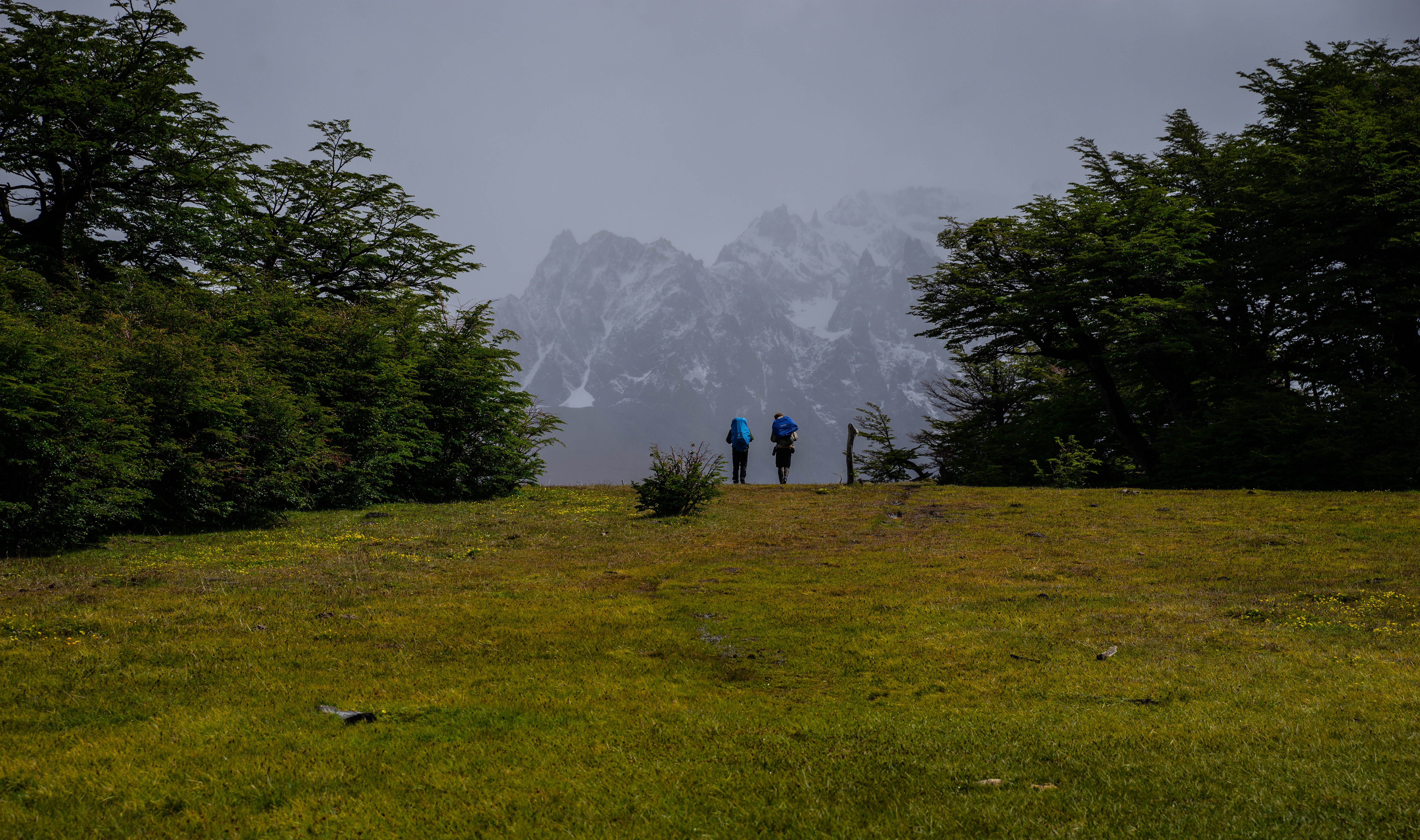
The path then bends to the right and a view opens up into a new valley. There we can already see the glacier in the distance, which we will pass the next day.
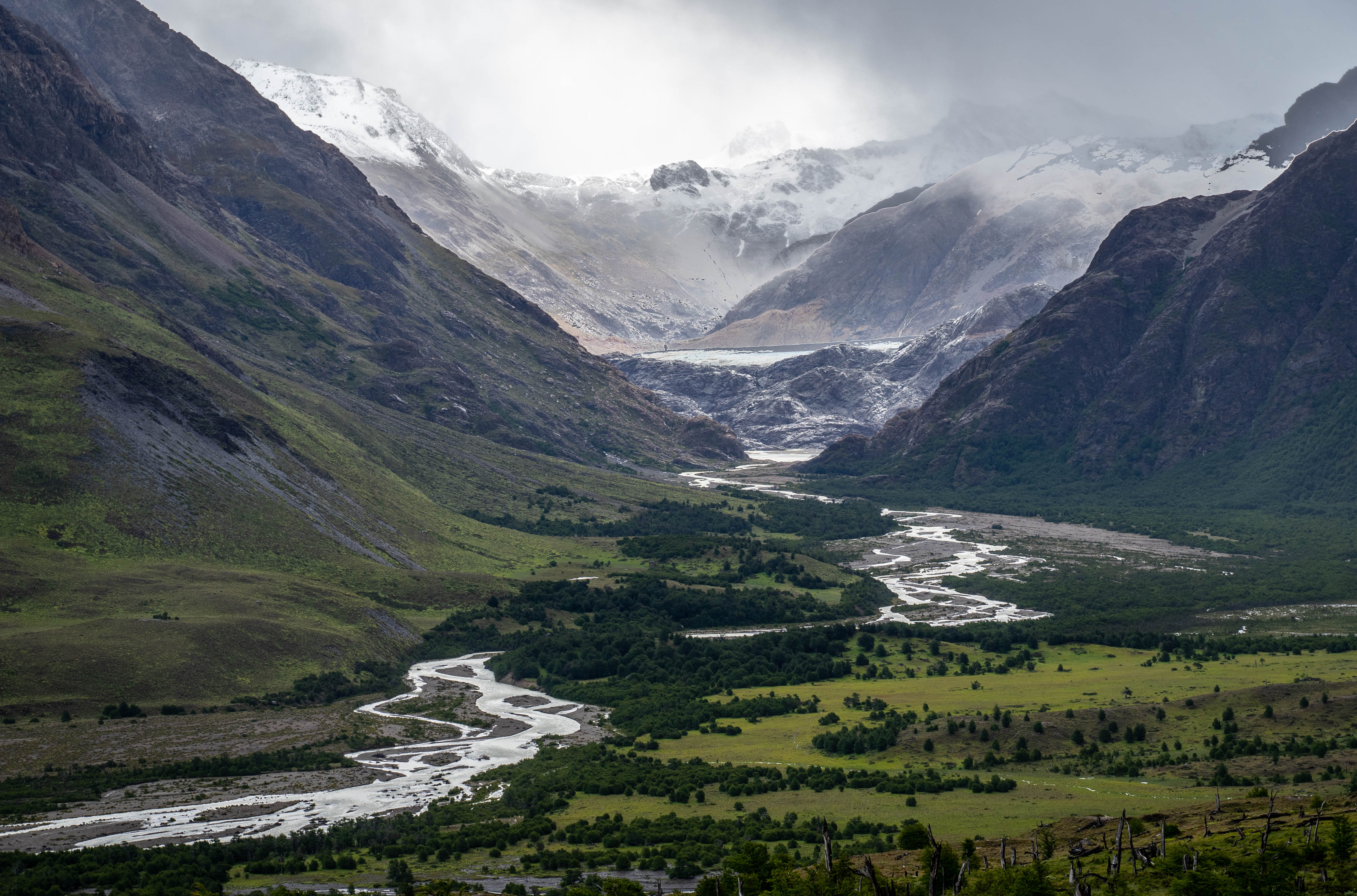
In the distance we can already see the rain again. But first we’ll get wet feet, because the first river crossing is coming up and there is no bridge or something to pass over like on the well-trodden footpaths around the Fitz Roy. Thus, we take off our hiking shoes, roll up our trousers and wade through the ice-cold water.

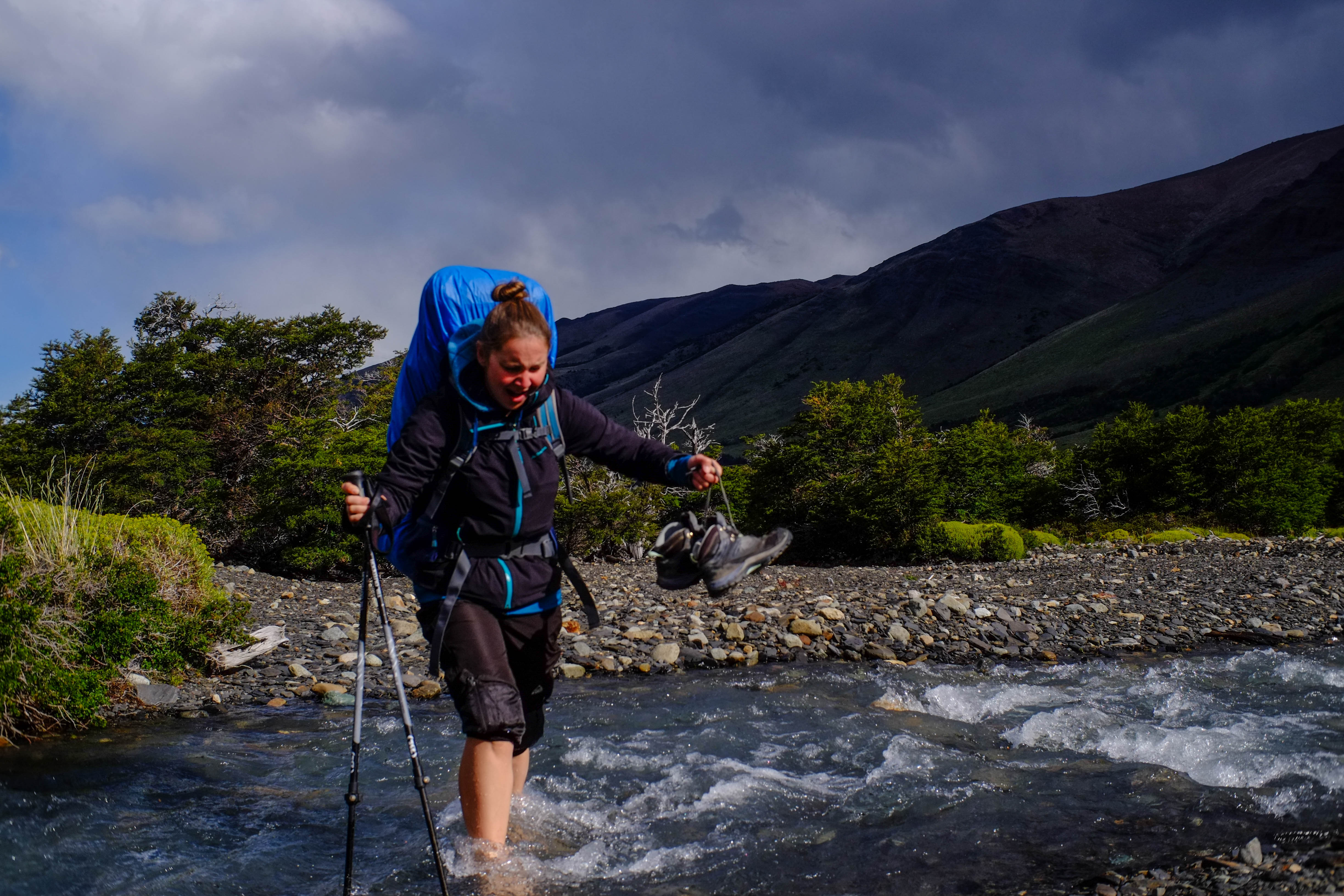
After our feet are dry again and back in your hiking boots, we continue through the valley towards Campamento Lago Toro. Of course there are more river crossings to follow.

In the end we take our shoes off and put them back on four times. The rain has started again and parts of the trail often turn into lakes.

Because of such places our arrival is delayed, as we are looking for ways to get to the campground with dry feet. Unfortunately this doesn’t work out very well and at some point there is a slight frustration because our feet are wet and very cold. When we arrive relatively wet at the campground, we are all relieved. But the campground is just a loose collection of branches that offer wind protection and very dark. There is a shelter, but it is so small that not even Diana can stand upright in it. Besides, mice have already declared it their home. After we have cooked noodles quickly, we go to sleep.
Day 2
Campamento Toro to Campamento Paso del Viento crossing Paso del Viento – 13,4 km
Wake up. Roll up the sleeping bag. Pack up pillow. Stow the mattress. Hand out backpacks from the tent. Diana cooks porridge with pears. Lucas packs the tent up. Enjoy breakfast. The same procedure on every hike.
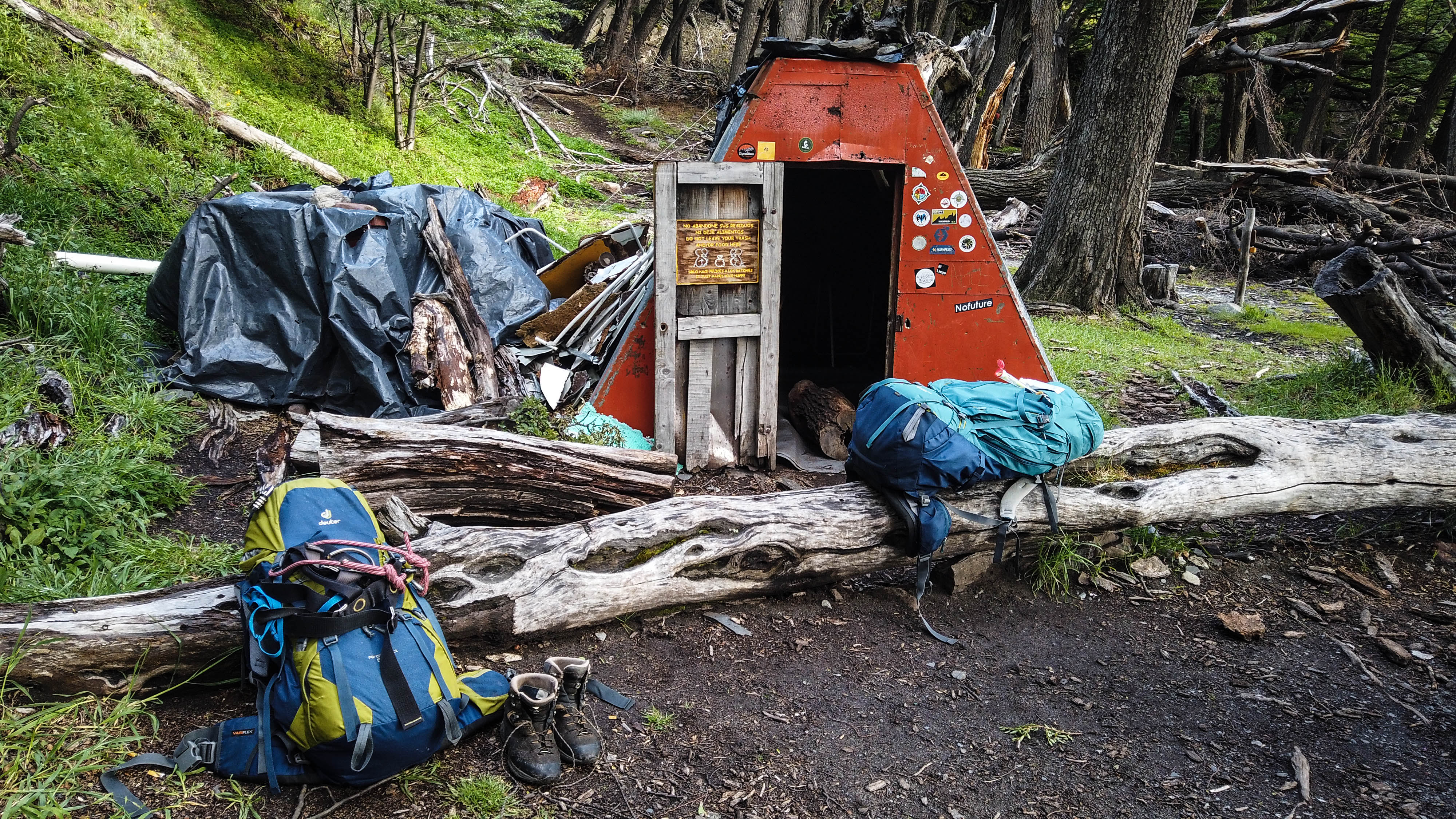
After the rustling of the branches has „sung“ us to sleep, it is very quiet the next morning. We are happy, because it seems to be very calm. But when we start walking we do not suspect yet that it should probably be one of the most windy days of our life.
The APN recommended in their introduction video to the Huemul Trek not to do the second day at high wind speeds. According to our trusted weather service the wind should slow down around noon. We trust this and fight our way through strong gusts of wind along Lago Toro.



The gusts of wind are extremely strong and force us to take breaks or unexpected interruptions near the ground. For Leandro it is too much and he turns back to the campground.

So we continue the way as a group of four. Soon we reach the place about which there has been much speculation: the zipline!
Diana looks at the construct and decides to cross the river at a higher point. But Finn, Jirka and Lucas don’t want to miss the fun with the climbing harness. Meanwhile the sun is shining again and the zipline is also more or less in the slipstream of the surrounding rocks.
Lucas puts on the climbing harness first, hooks up properly and pulls himself over the gorge. But on the other hand he realizes that this plan was not so well thought out, because we had not attached a rope to pull the backpacks. So he comes back again, pulls on the backpack and crosses the canyon a second time. Luckily, because climbing across is a lot of fun!

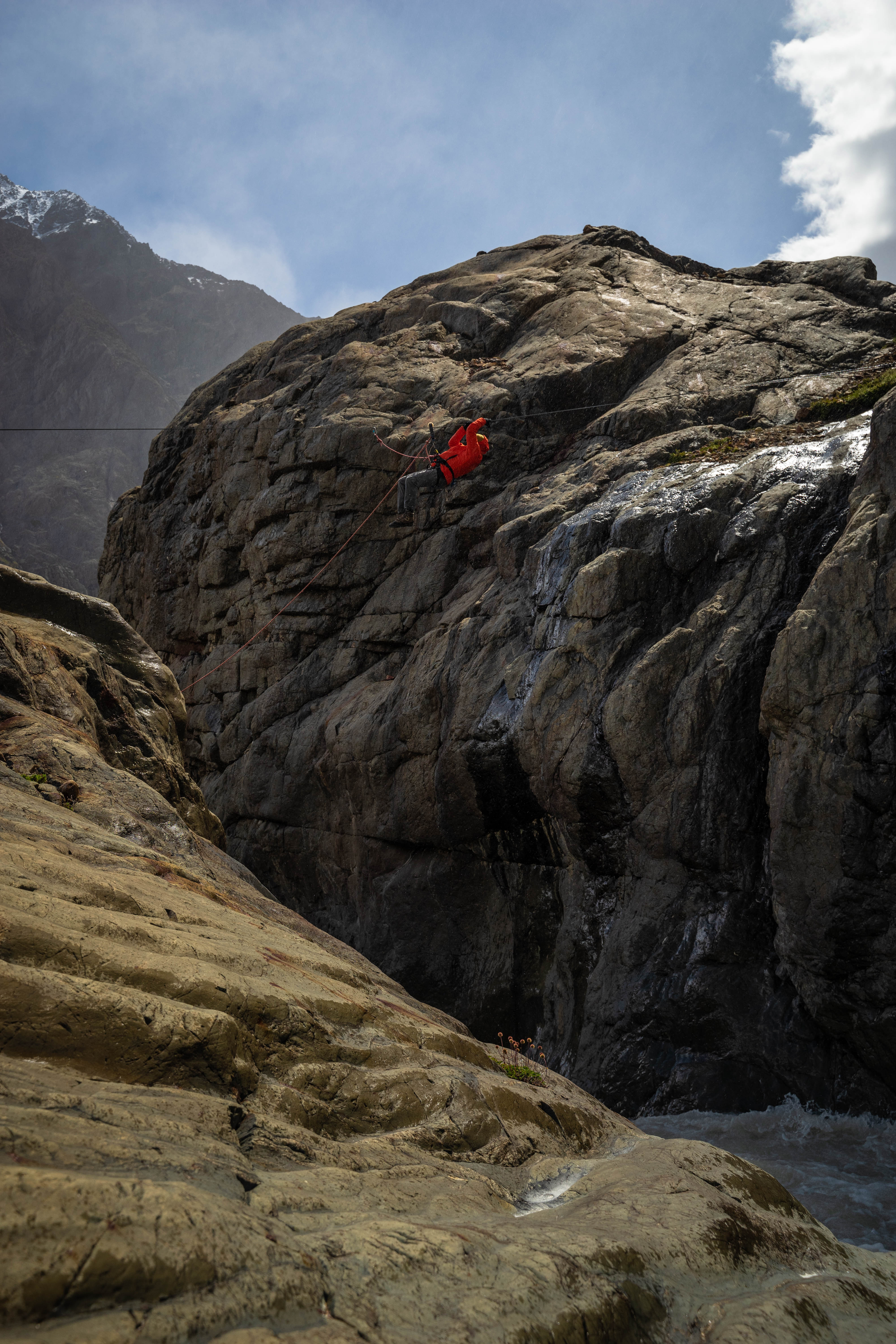


Diana has also made the crossing and so we continue our way together again. Soon we pass the glacier over a steep slope that we could already see from a distance.
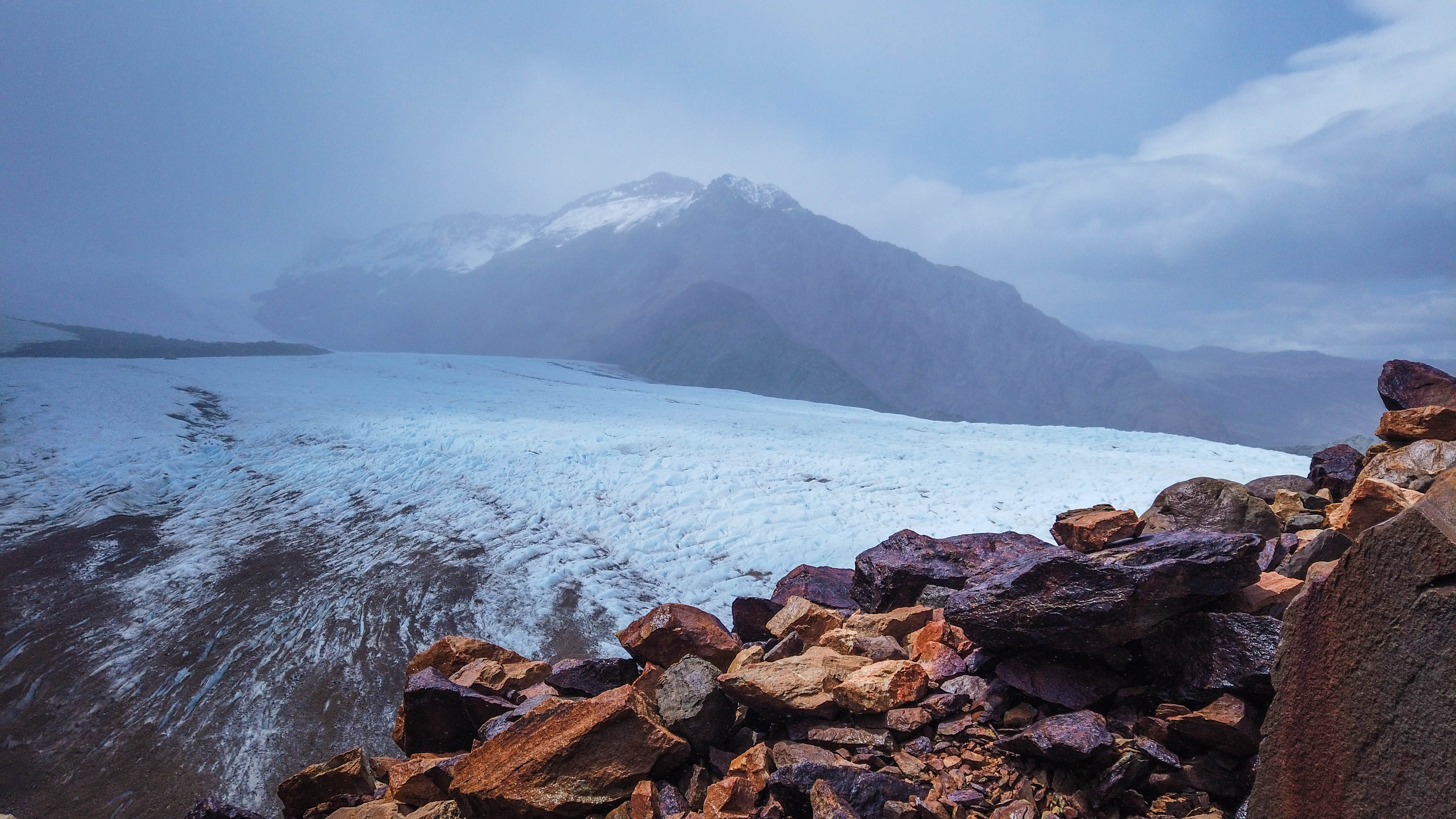
The wind blows tirelessly and we fight our way up just as tirelessly. Finally, a first highlight of our hiking tour waits shortly behind the Paso del Viento, the pass of the wind.
After a strenuous ascent we reach the highest point of our hike. At 1,412 metres above sea level, the wind whistles cold and an even smaller iceberg floats on the small lake.
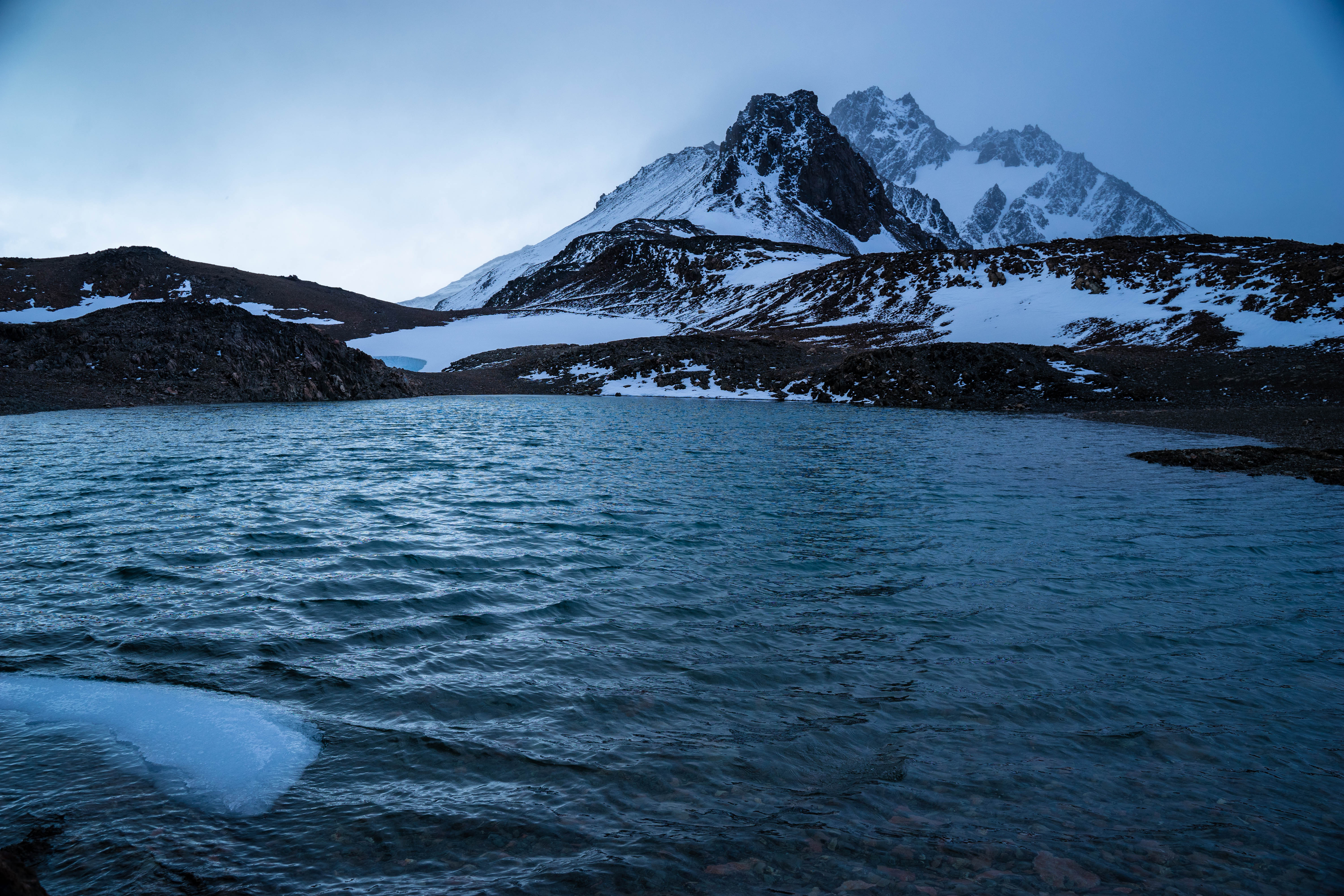
Then we reached a real highlight of the hike – a view over the Patagonian inland ice, the Campo de Hielo Sur. Not only does this sound impressive, it is also the third largest ice field on earth, or the largest continental ice field outside Greenland and Antarctica.
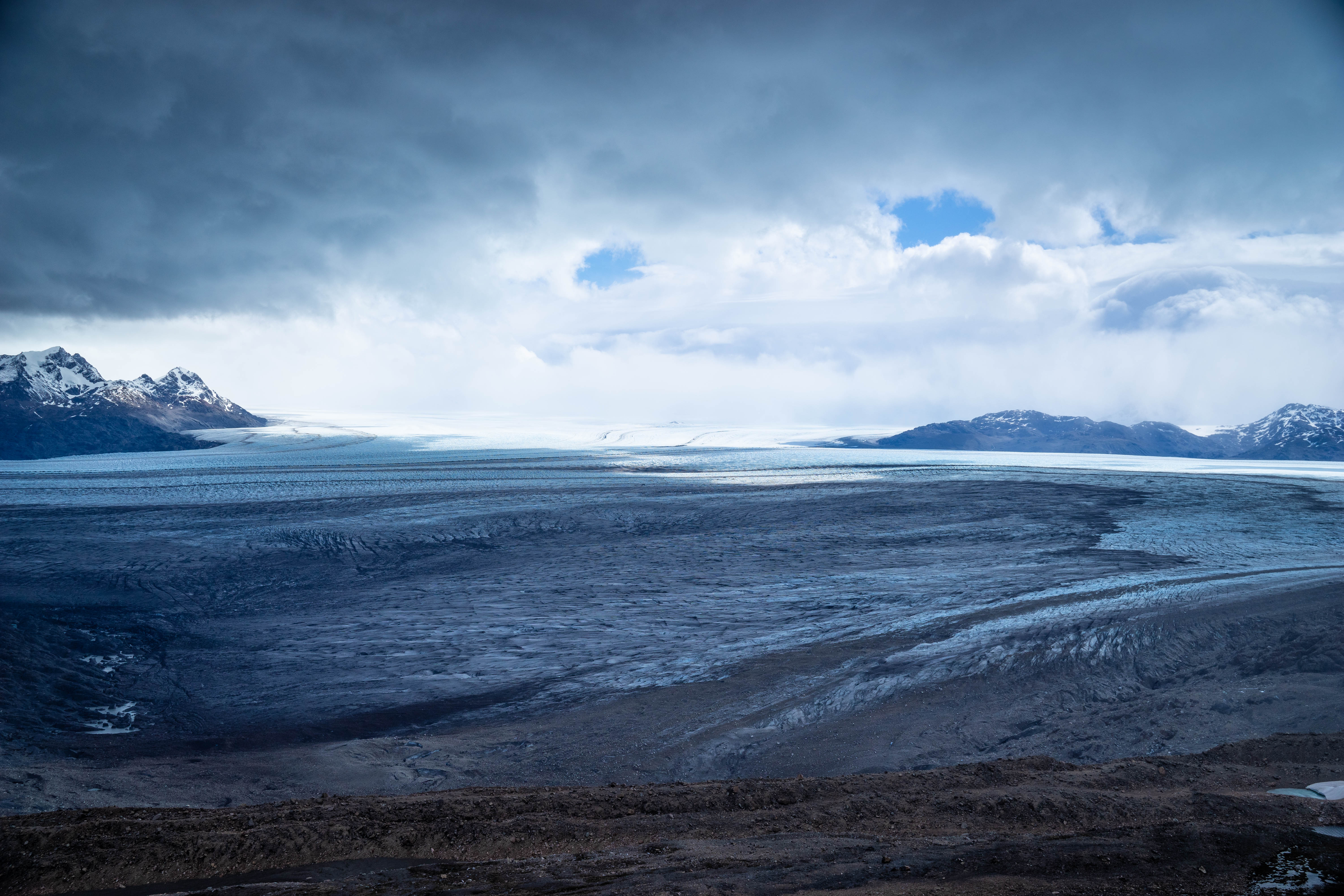

The last kilometres up to the campground Paso del Viento are a stretch and we are literally used by the wind as a play ball. So the relief is huge when we finally arrive – just like the surprise! The campground is under water.
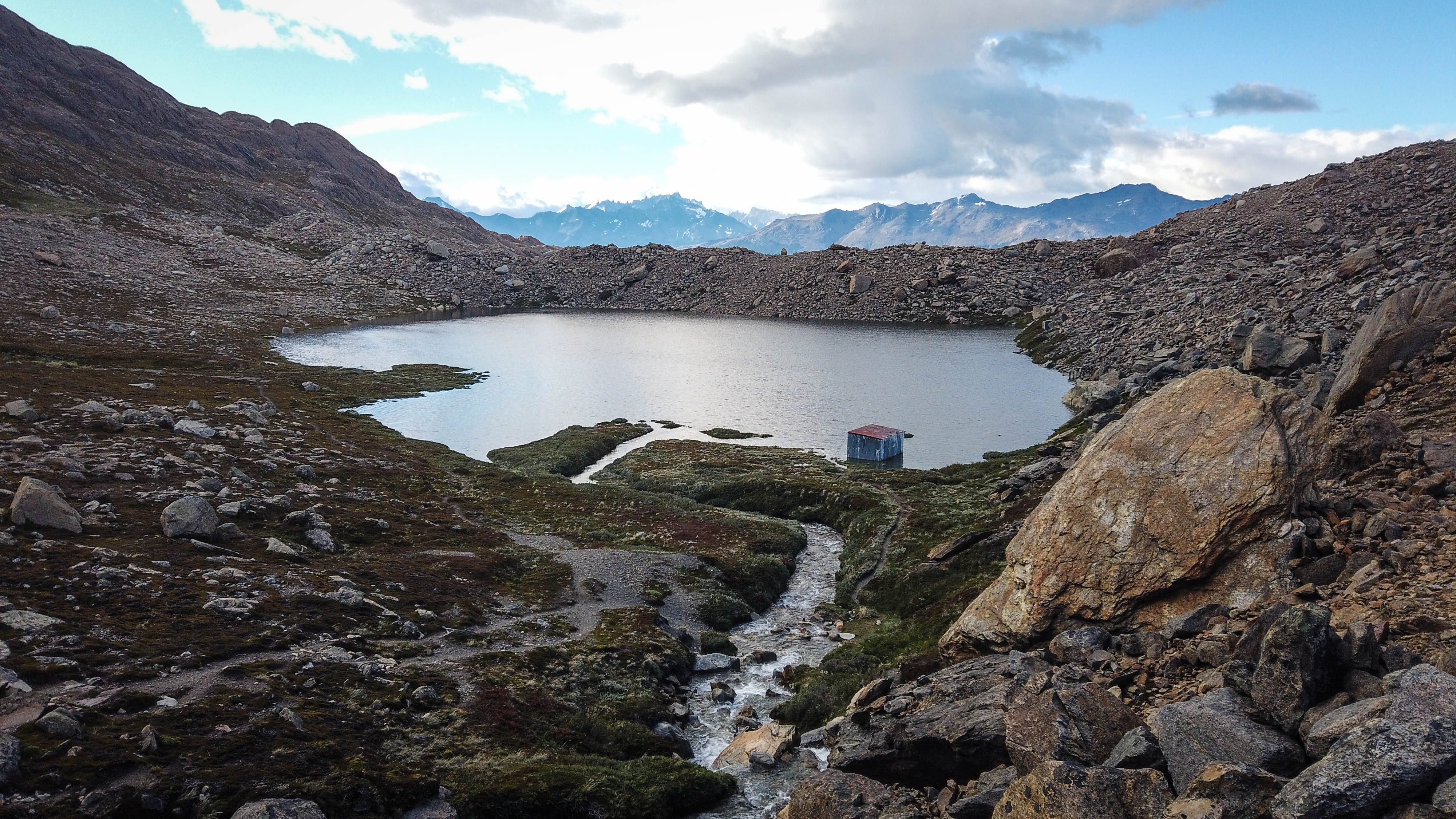

Fortunately there are a few places left, a little above the actual campground. Here, however, no facilities of any kind have been provided, not even a basic toilet has been built. With the view to the beautiful mountains in the area it is nicer outside anyway.
Day 3
Campamento Paso del Viento to Campamento Bahía de los Témpanos – 15 km
The day begins with our usual routine.
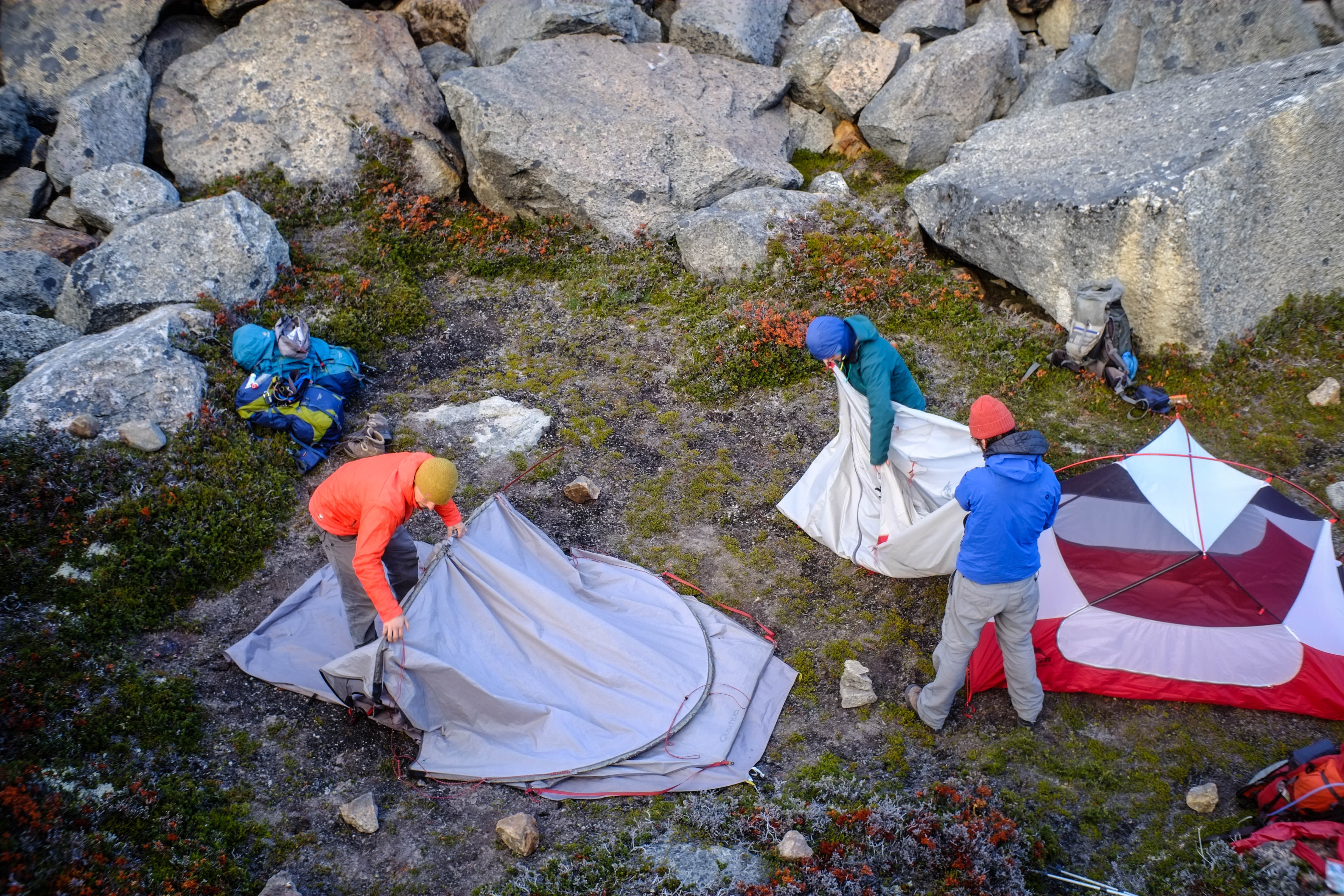

The day also has a good start! The sun is shining, there are only a few clouds in the sky and there is almost no wind. A very welcome development, especially in thoughts of the previous day. We start early today, because we heard that the next campground is very small and you might not be able to get a place. So we start shortly after 7 am – and so we are the second last group of our campground. However, this does not matter, because we want to enjoy the day, because it still goes a good piece along the big ice field of the Campo de Hielo Sur and the Viedma glacier, the biggest glacier of Argentina.
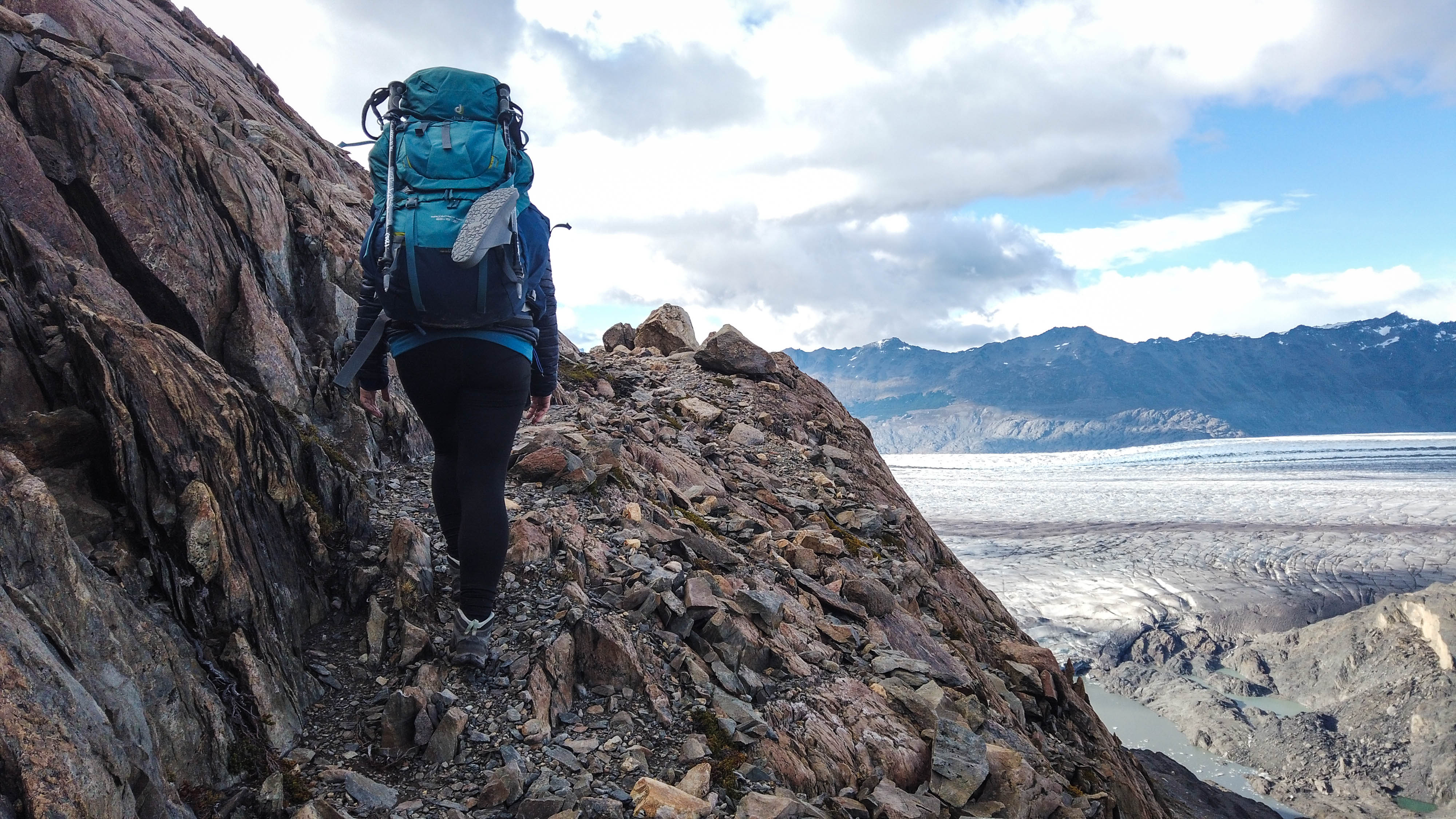

The path meanders further and further upwards before we reach the Paso Huemul at about 1.000 HM with blue sky.
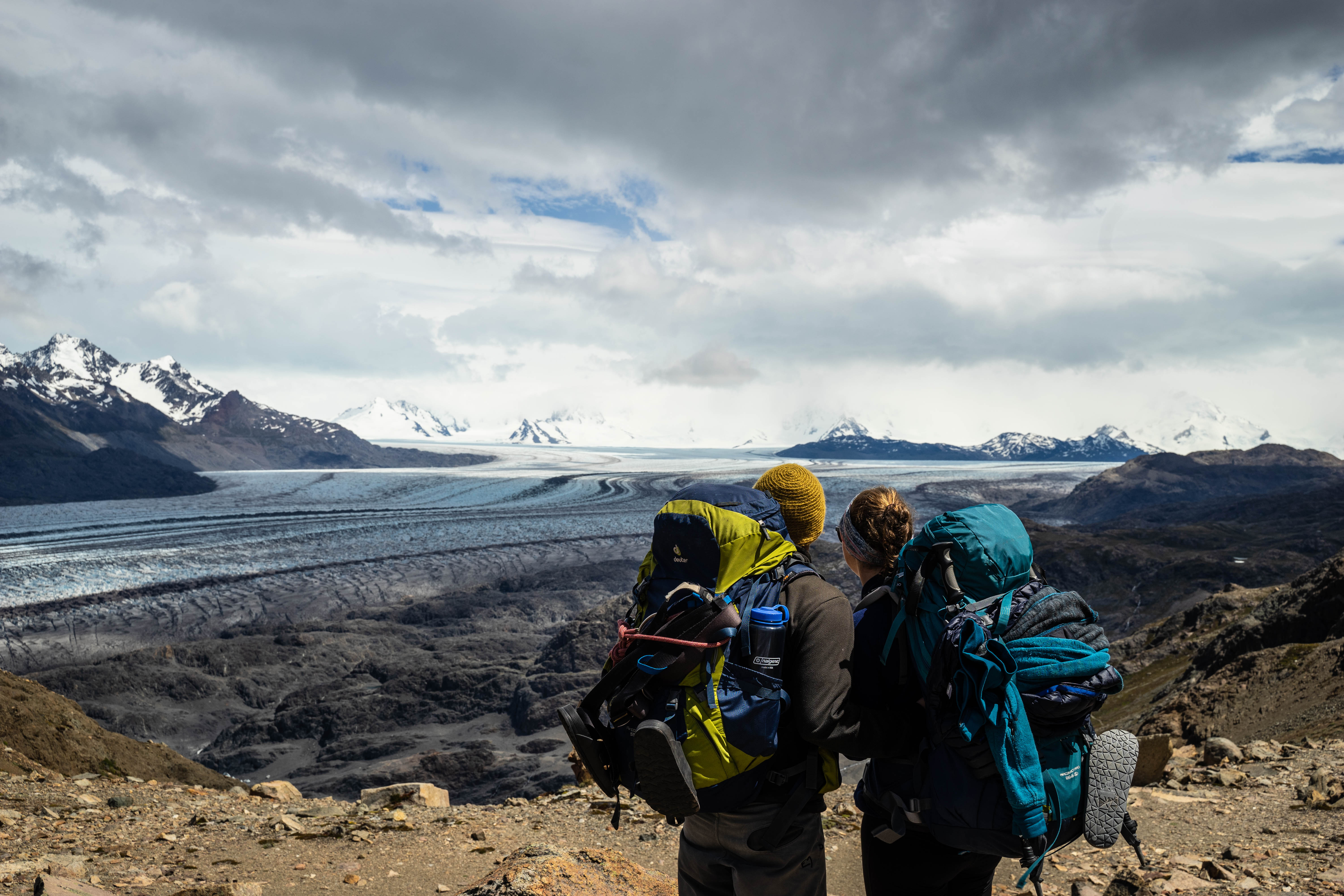
After that, our view changes abruptly and we see again the huge Lago Viedma that we could already see from a distance on the first day.
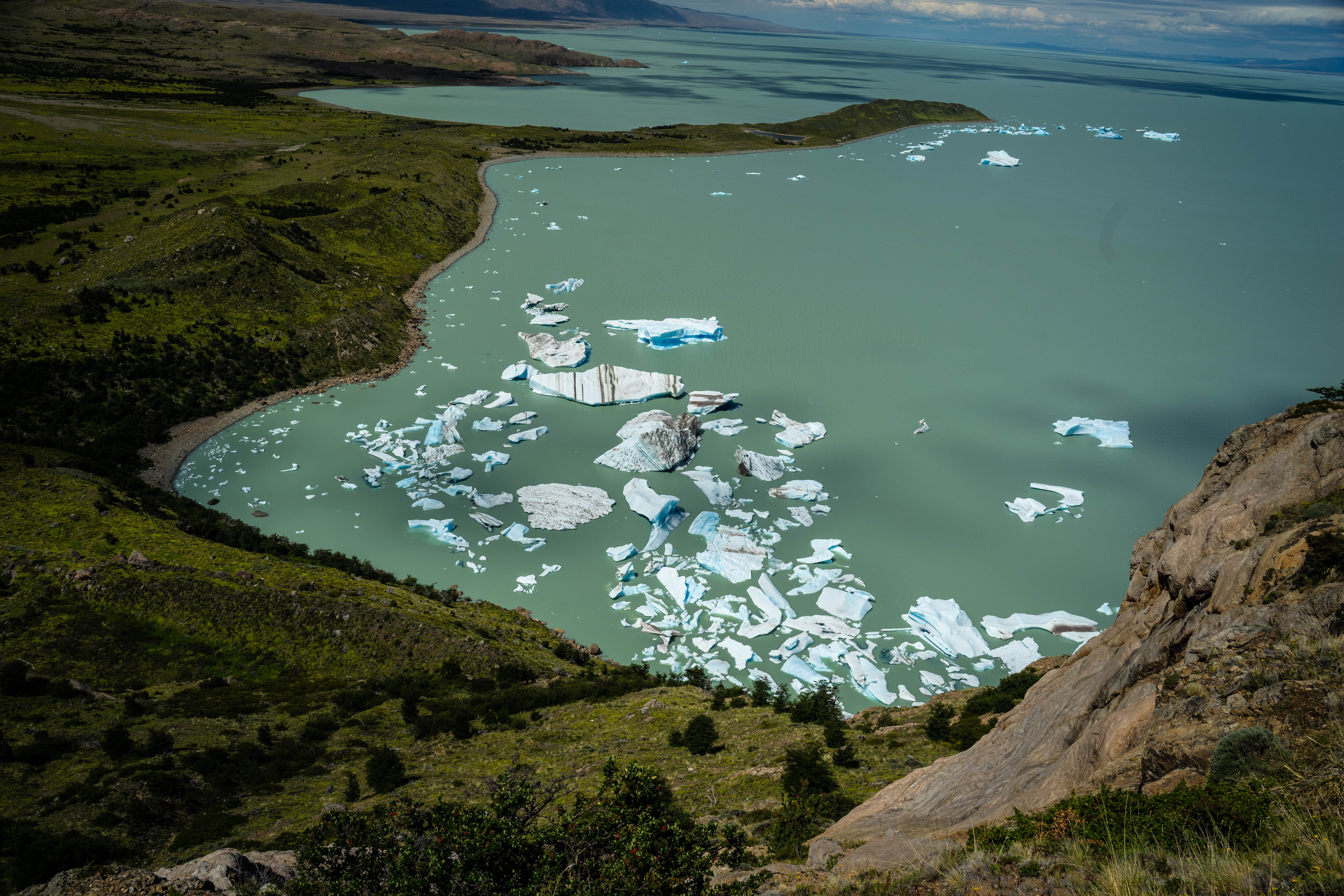
A very steep descent through the woods follows. Over 3 kilometers it goes down almost 750 HM. But in the end we arrive just in time and can get hold of one of the much sought-after camping sites at the Bahía de los Témpanos. As soon as the tent is set up, Lucas already pursues one of his favourite activities.


Later a group that we already know from the hostel joins us and we spend a nice evening together.

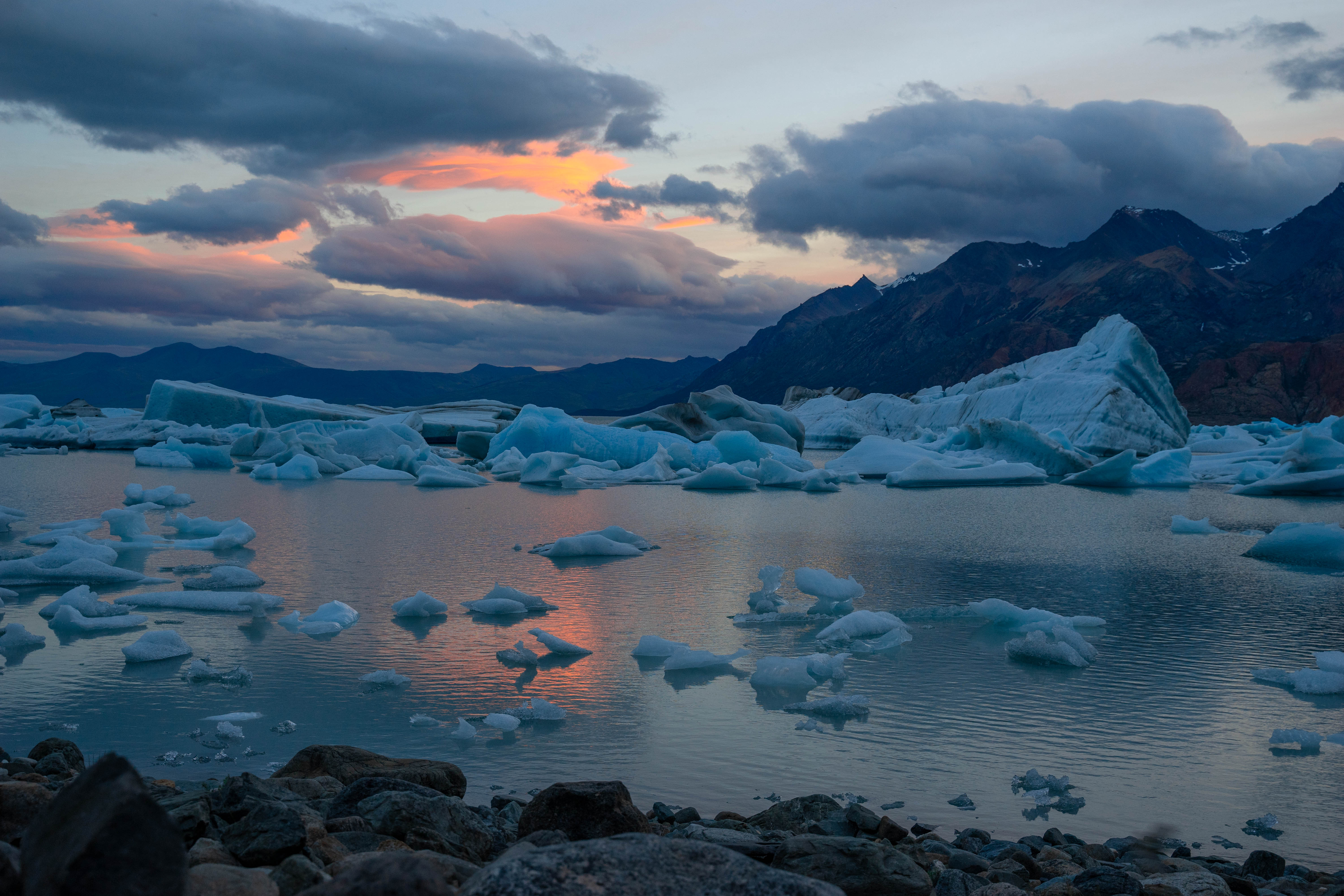
Day 4
Campamento Bahía de los Témpanos to Administración Parque Nacional – 25,5 km
After our usual breakfast, which we enjoyed this morning with a view of the icebergs, we start our last leg of the Huemul Trek.
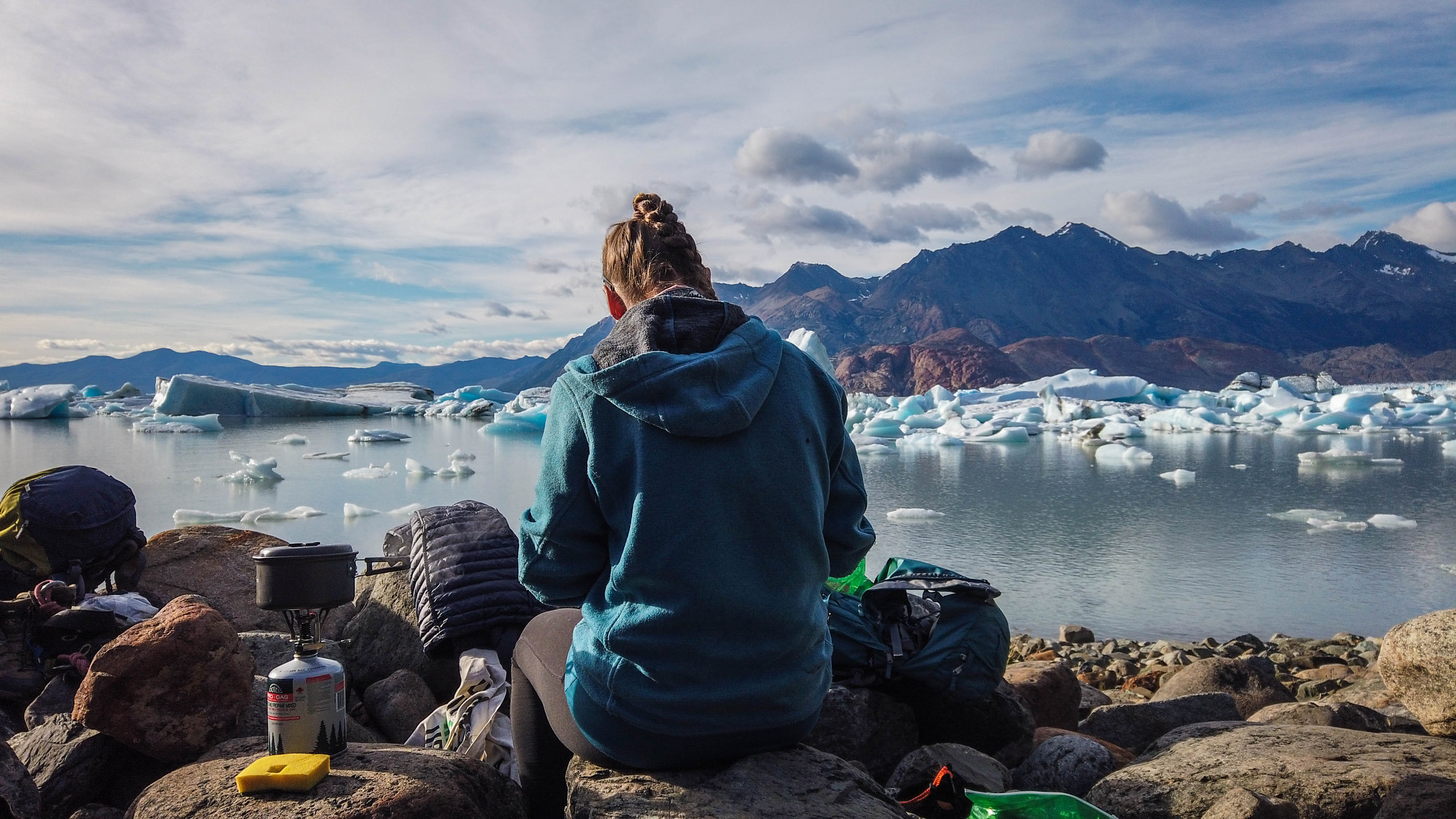
The weather is also great again and we can hike in our T-shirts. The hike leads us back towards El Chaltén with a great view in the back.

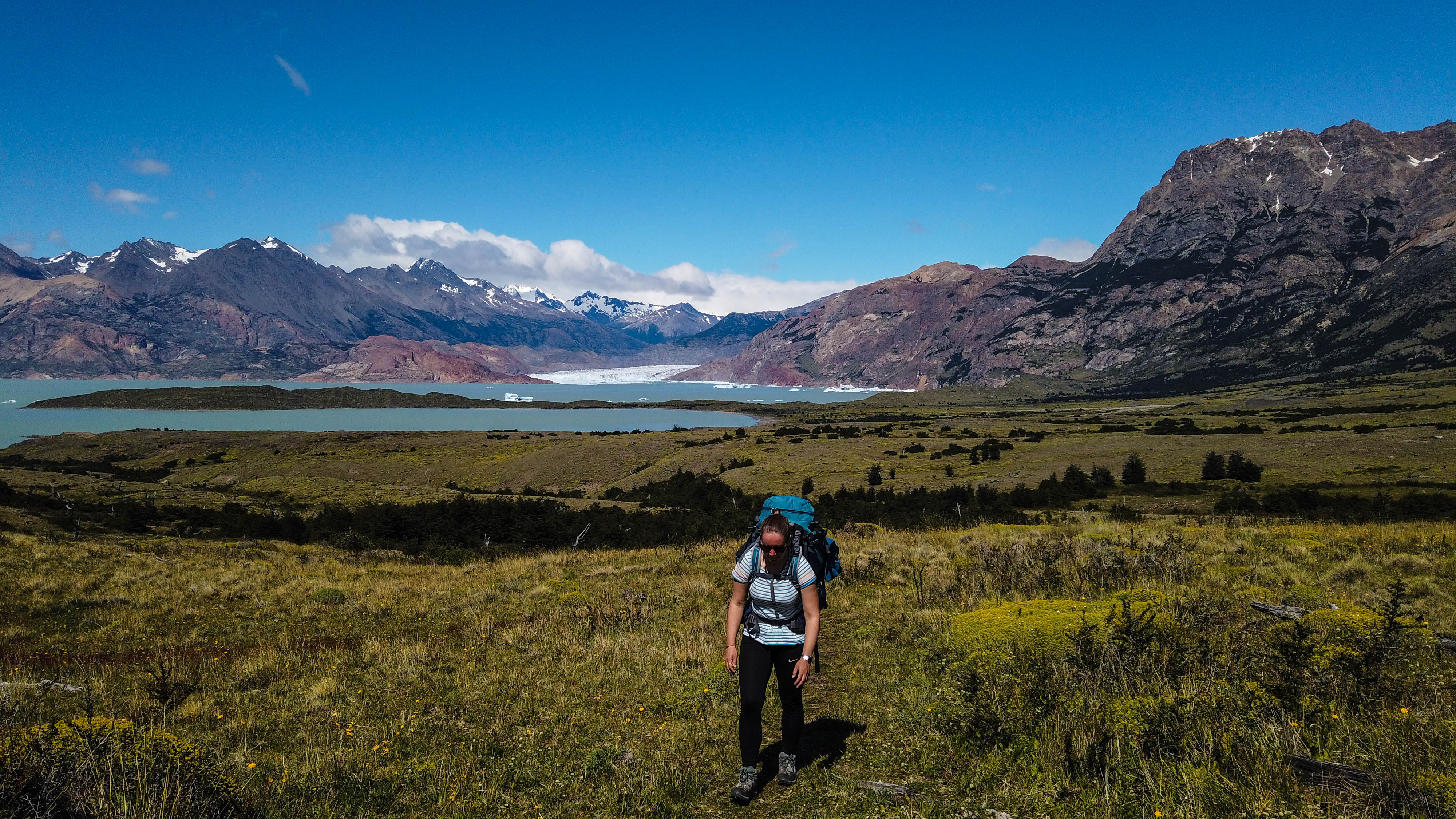

After we came back to the lake, we had to do another zipline crossing. It was longer, but not very spectacular, because it was only crossing a river in 3-4 m height. In this case Diana also decided to cross the river with the zipline. Afterwards we walked leisurely along Lago Viedma before we came to a landing stage. Here some hikers decided to try their luck hitchhiking, but we took the path to the left to really finish the trek.
The sky is blue and we take a meal break before we start the last kilometers of the trek. For this we have saved a cake to give us enough energy after the exhausting day. This works great! Slowly the Fitz Roy moves into our field of vision again and an unexpected mountain joins us – for the first time since our arrival in El Chaltén we can see the Cerro Torre!
Actually, the hiking tour leads straight ahead over a road back to El Chaltén, but due to the great weather we decide to take an alternative route with a high altitude difference. Thus, we climb the Mirador de las Águilas, that we already visited, from the other side and therewith experience a great panorama before we arrive back in El Chaltén!

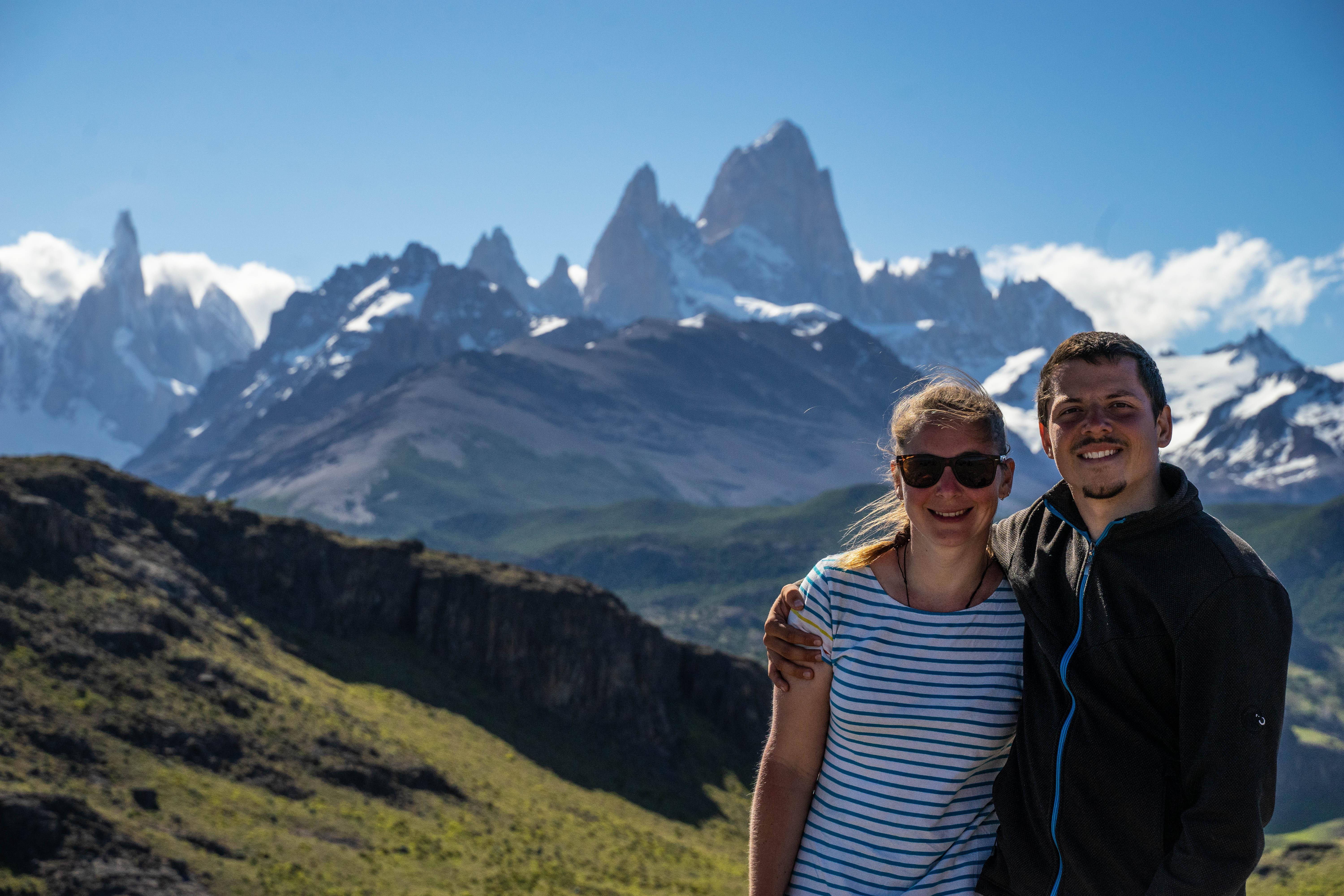

After enjoying the last view, we hike back to the APN, hand in our registration forms and finish the Huemul Trek! The trek was definitely exhausting, though breathtaking and spectacular at the same time. Definitely one of the best hikes we did on this trip! In the end the trek was 70 km long for us!

El Chaltén (30.12.19 – 02.01.20)
Back from the Huemul Trek we had to relax for a few days. But this didn’t mean to put our legs up for everyone, because the weather forecast for the next day was excellent and so Lucas and two others left the campground for a muscle ache fight hike to a viewpoint on the Cerro Torre. After the group of three had walked through the forest for about an hour, they had already reached the great viewpoint!
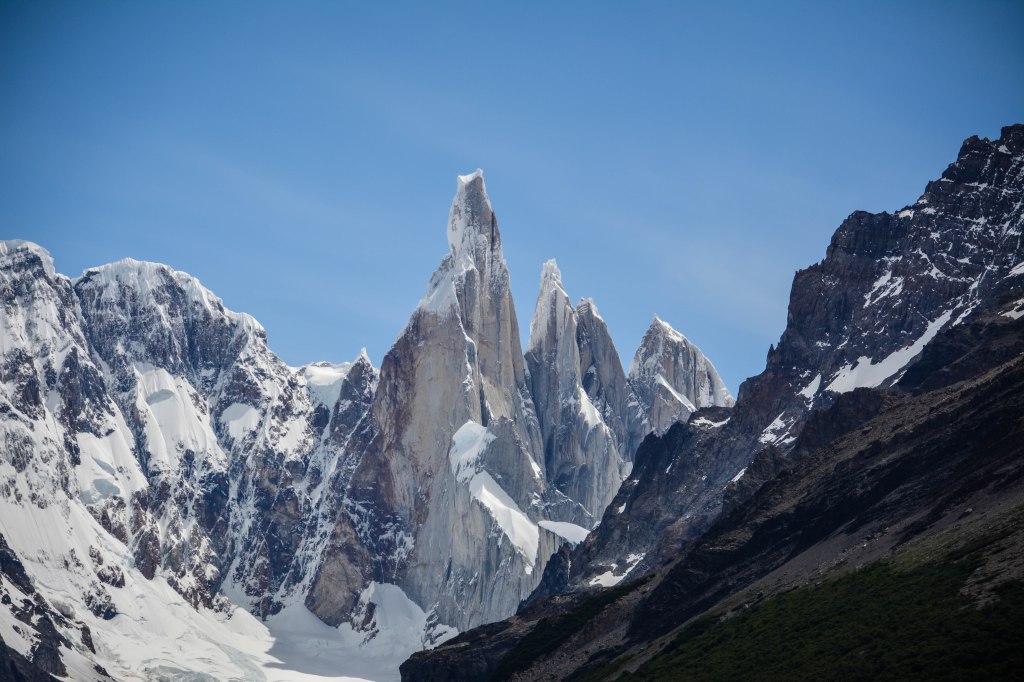
Many stories entwine themselves around the first ascent of Cerro Torre. The two alleged first climbers Egger and Maestri in 1959 could not prove their success, because Egger had an accident on the way back from the summit and carried the camera with the proof photo. In the climbing world, the success or failure of the two was long discussed. In the meantime the mountain has been climbed several times. The route that was climbed by Maestri and Egger was removed by another climbing group from the USA and Canada, making this route virtually impossible.
The Cerro Torre always provides a magnificent view.


On the way back we had the pleasure to see a Magellanic Woodpecker once again. This time even closer than the previous times:
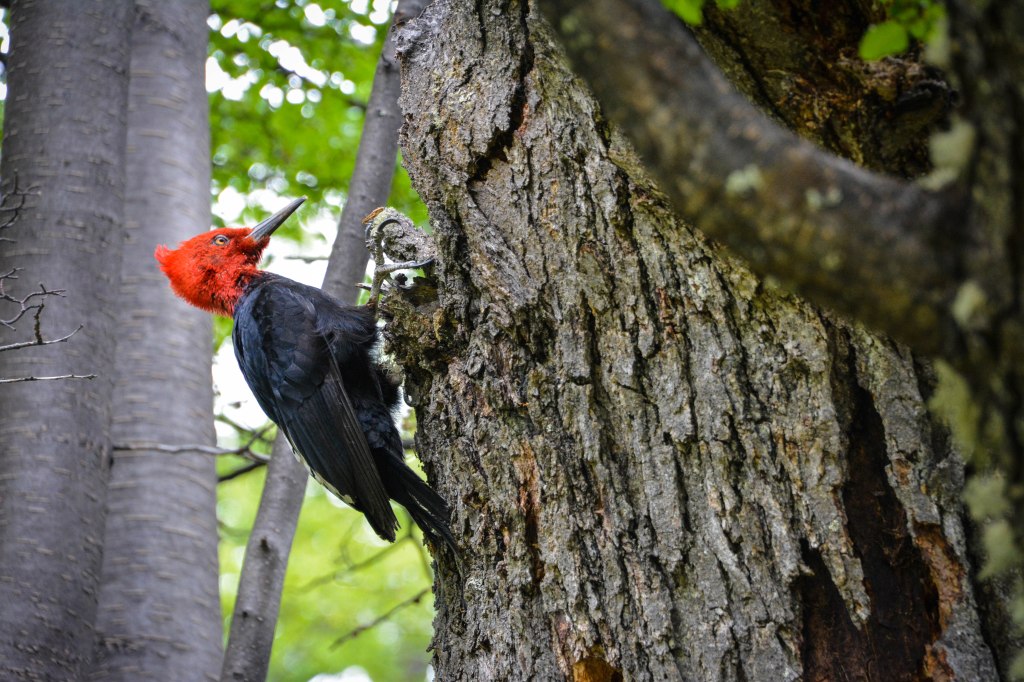
But that should not have been it yet with the great mountain panoramas. In any case, we spent New Year’s Day with a full belly and a lot of beer and/or wine in the Casa Azul, our favourite campground of El Chaltén. After approximately two hours of sleep, our alarm clock rang again at 4.30 a.m. Half drunk and half sleepy we woke up Jirka and a few minutes later we set off in direction to the outskirts of the village. On the way we met some characters who had rung in the New Year properly and staggered home. But for us it went on purposefully, past the APN and to the nearby lookout point. Getting up early should also be quickly rewarded.

It’s about 5:30. It’s fresh and we’re just waiting for the sun. But it takes its time and we are still waiting a little bit. The headaches from the evening before are omnipresent and we wonder why we got up so early. But in one fell swoop the headache is forgotten when the sun rises 10 minutes later:

A few minutes later the whole mountain range is red:
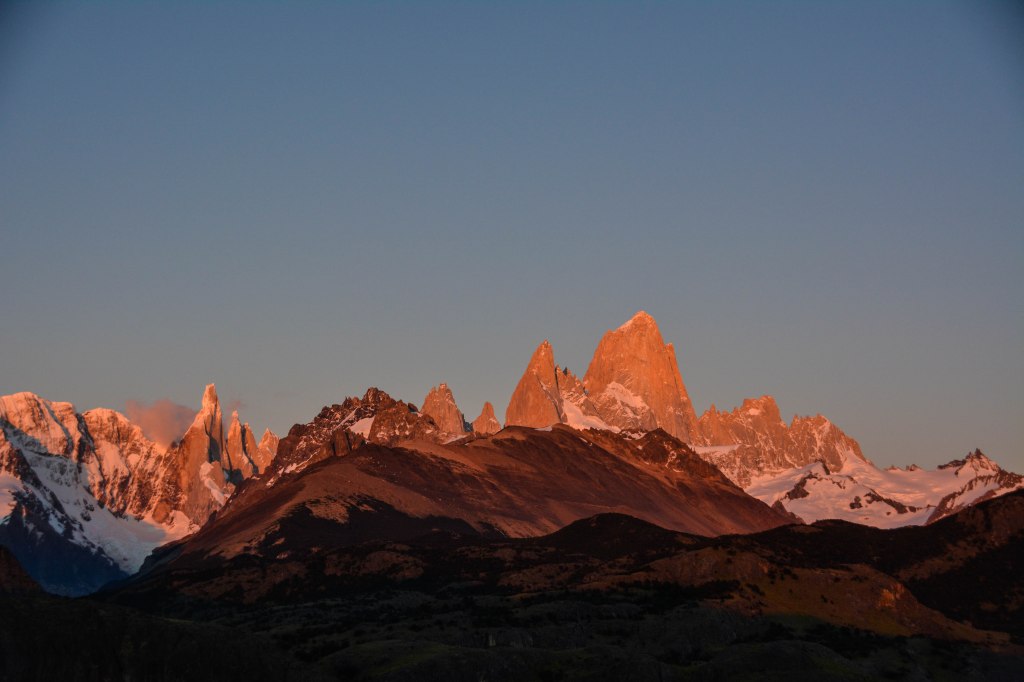
We can’t shoot enough pictures and the question if it was worth getting up early can be answered with yes!

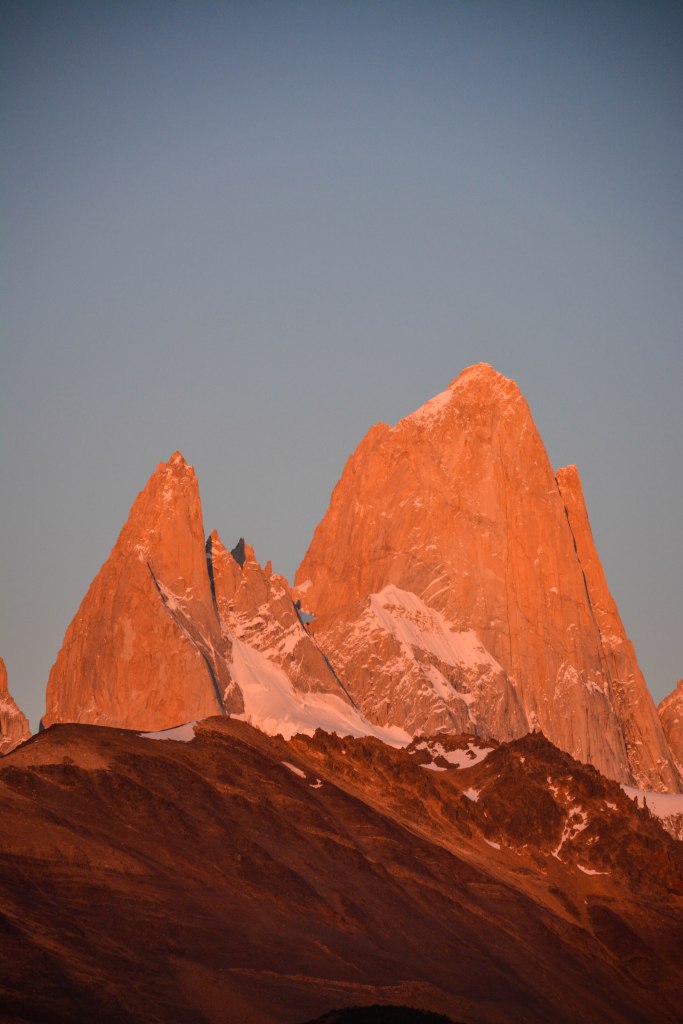
We enjoy our belated New Year view a little before we walk back to the tent to catch up on the much needed sleep.
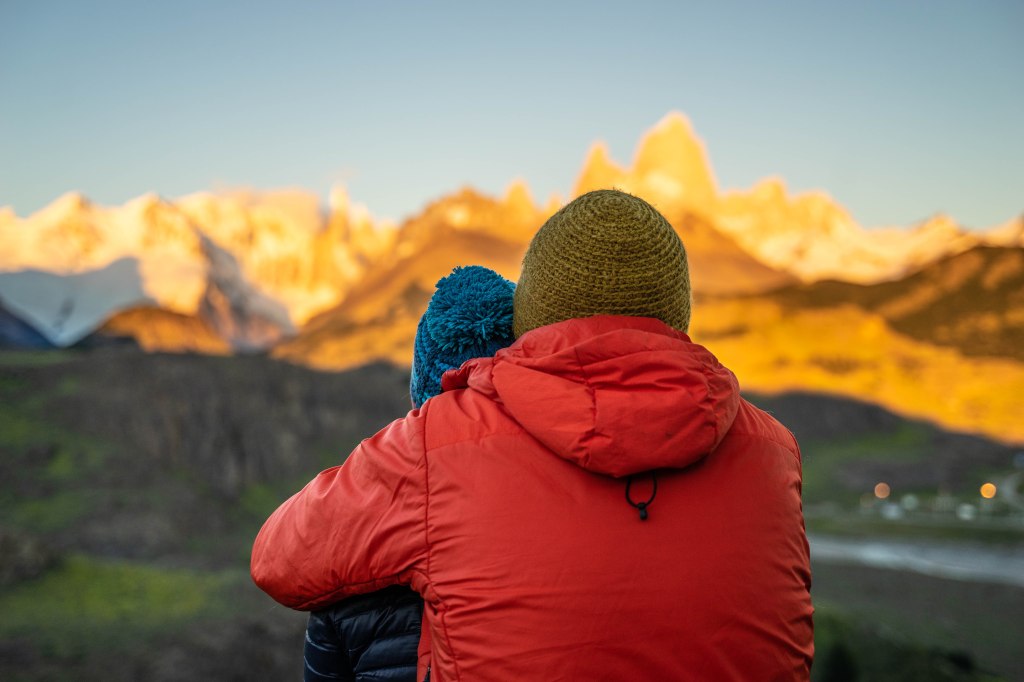
The 1.1. we spend relaxed and without doing anything. After about two weeks it is time for us to leave El Chaltén and travel further north. Of course we continue our journey by hitchhiking.
Ruta 40 (02.01. – 03.01.20)
In the morning at 9.00 o’clock we stand armed with a sign at the exit road of El Chaltén. We have no clear destination for the day, just as far north as possible. We wait about 3 hours before a tourist couple takes us up to the famous Ruta 40.

At the fork in the Ruta 40 we meet the good-humoured Brazilian Lucas. His mood is contagious and we get the next leg of the journey – altogether five of us – together, on the back of a pick-up truck. With the Patagonian winds definitely a unique experience!


When we are in Entre Lagos, they let us out in the middle of nowhere and we already prepare ourselves to camp in the nearby village. At the place where we stand, several travellers were probably already desperate. At least if one can believe the street poetry.

„Roses are red, Violets are blue,
It’s been two hours I’m waiting here and I really need to poo,
I sincerely hope this doesn’t happen to you! „
It didn’t happen to us. After about an hour a French motor home stops and packs us in. A few kilometers later the Ruta 40 really turns into a gravel road and over the next 70 km we get shaken up!
When we arrive in the evening in Gobernador Gregores, a small and very dusty place, we ask at the gas station whether we can put up our tent behind it. With the tip, where it is windstill, this is affirmed.
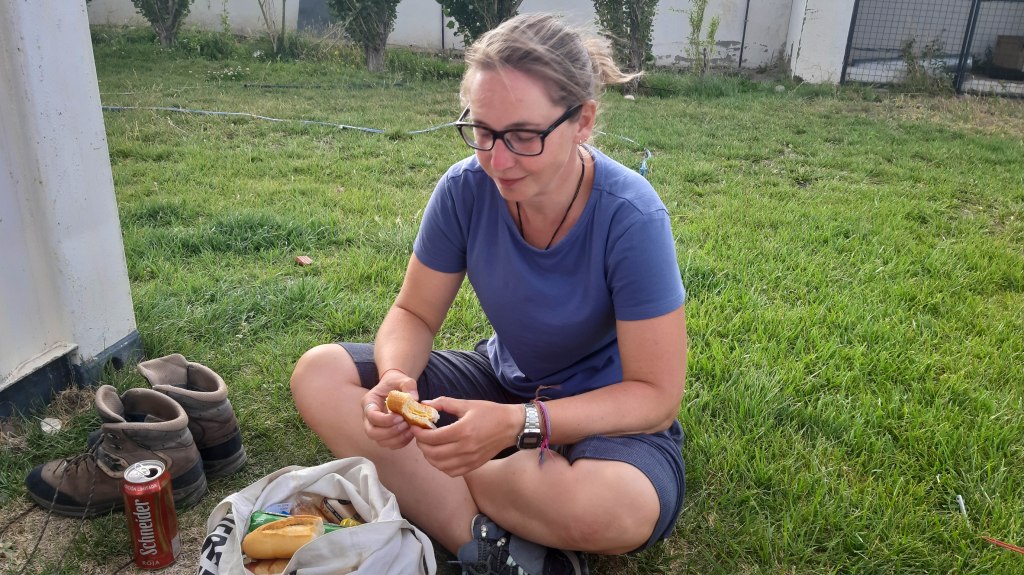
The next morning we continue the journey with the French motorhome. Along the Ruta 40 we can always see guanacos or emus. Three times we can even see armadillos at the edge of the road.


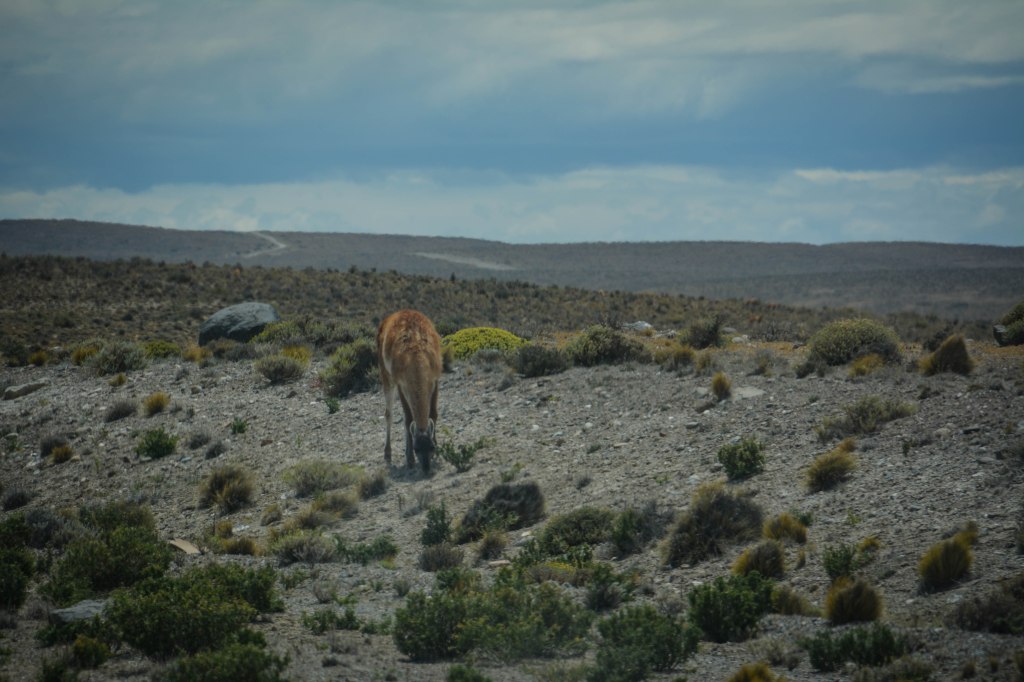

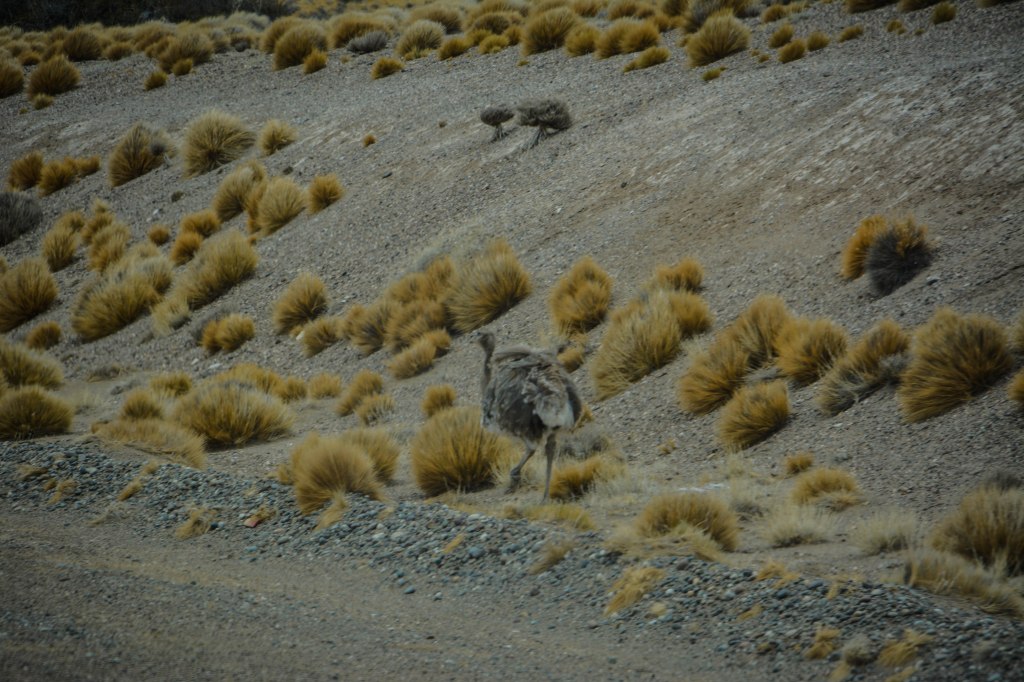
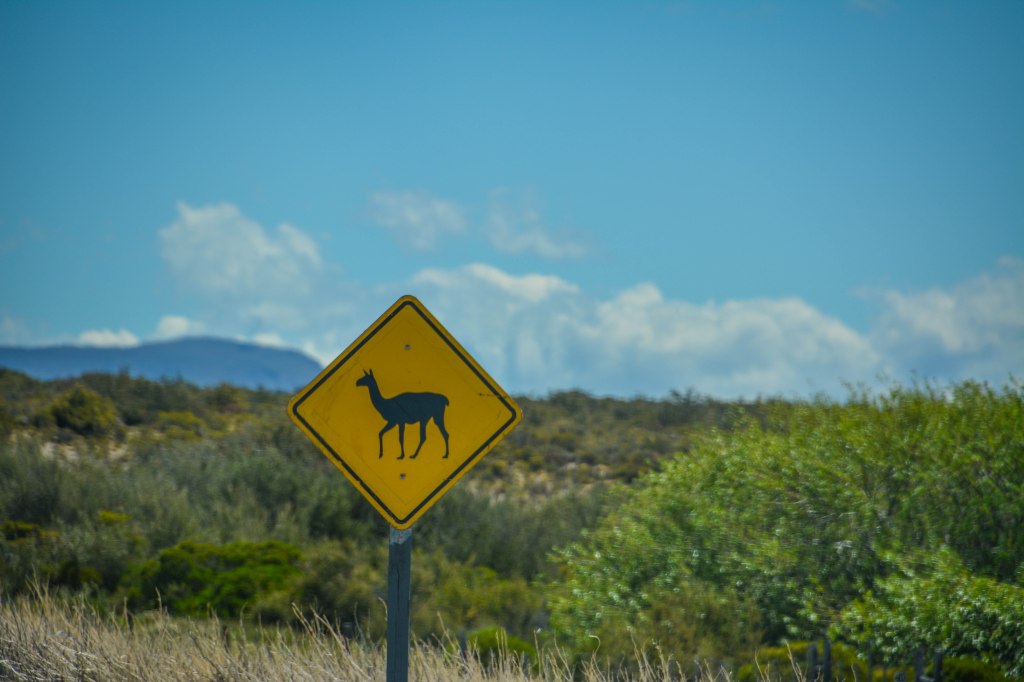
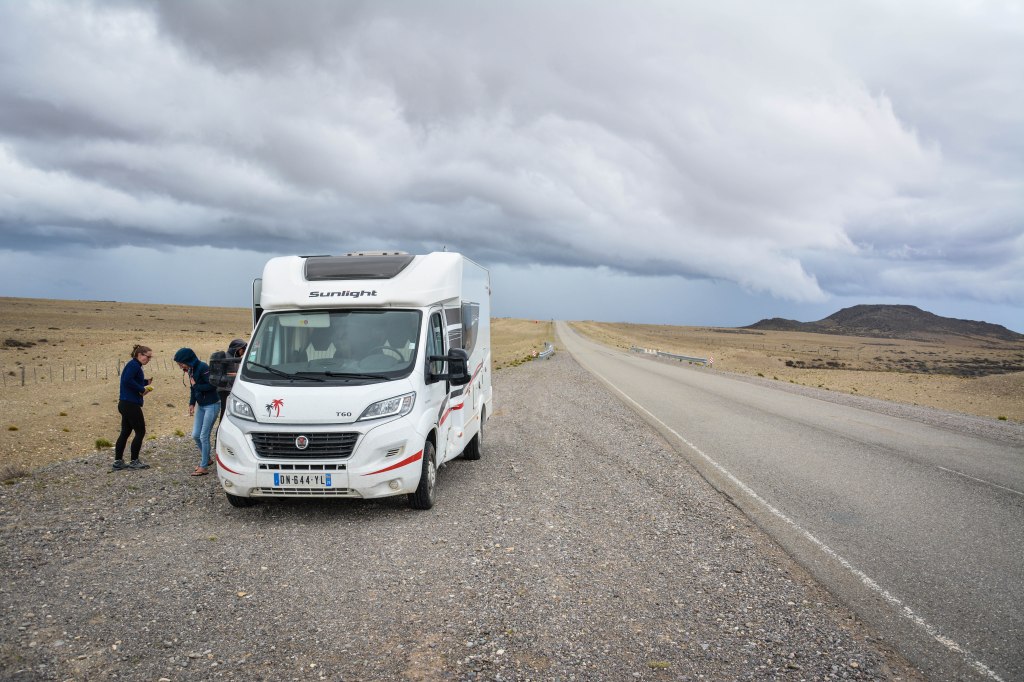


After three hours of pampa we turned right along Lago Carrera General and drove back towards Chile. The border crossing went smoothly as so often.

